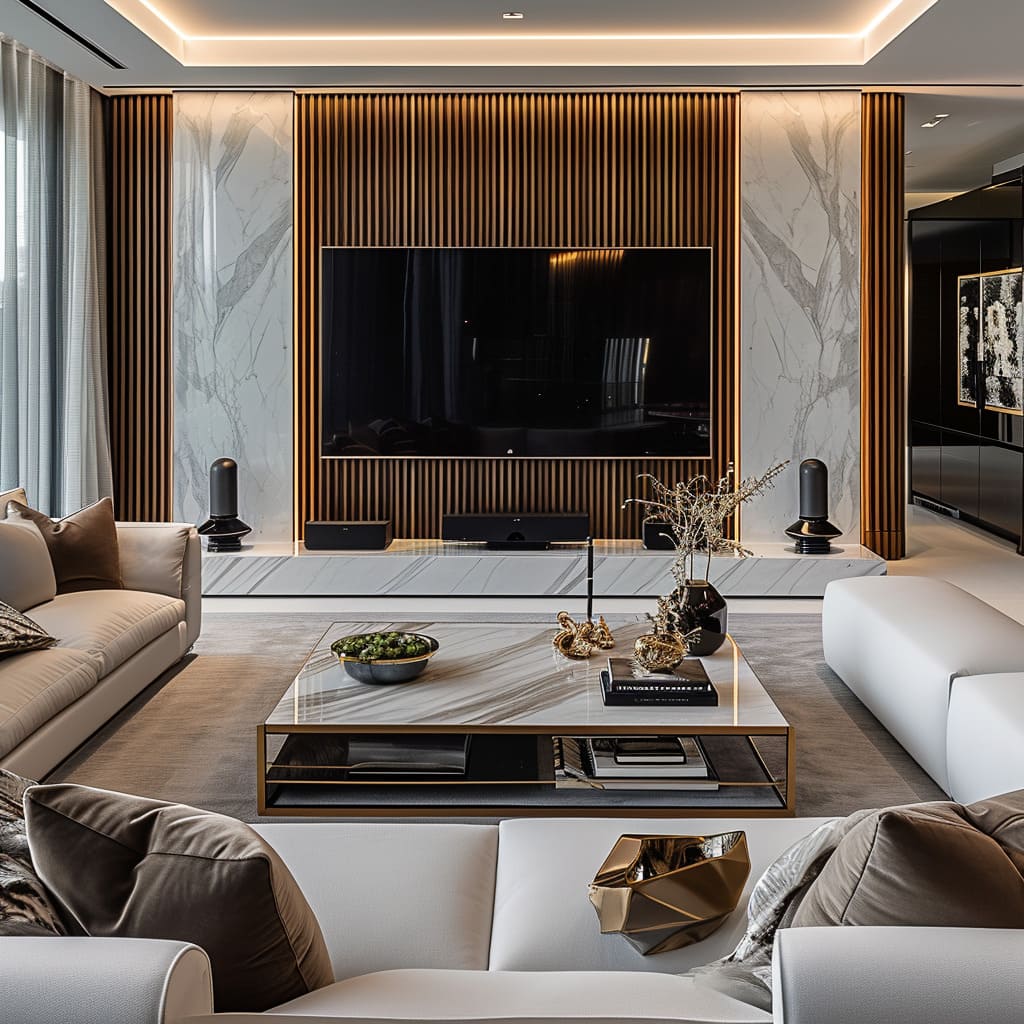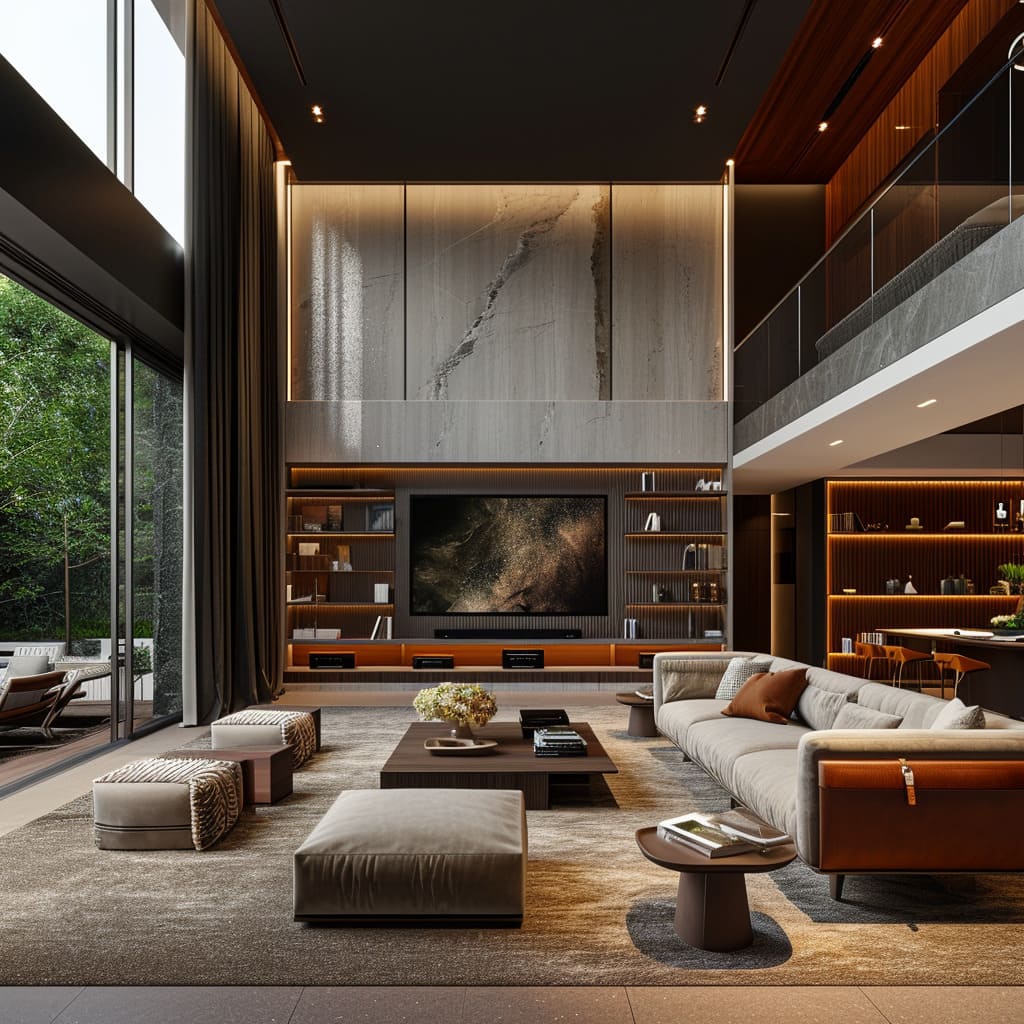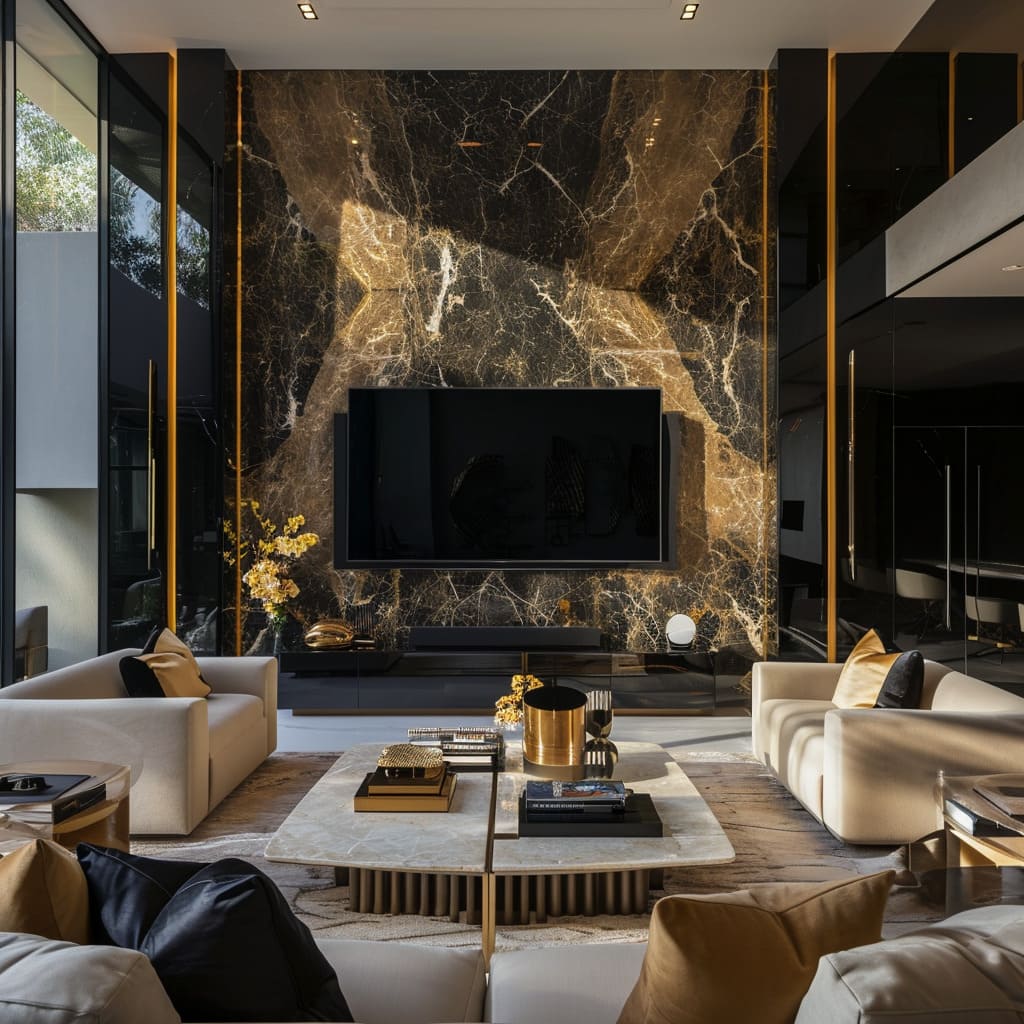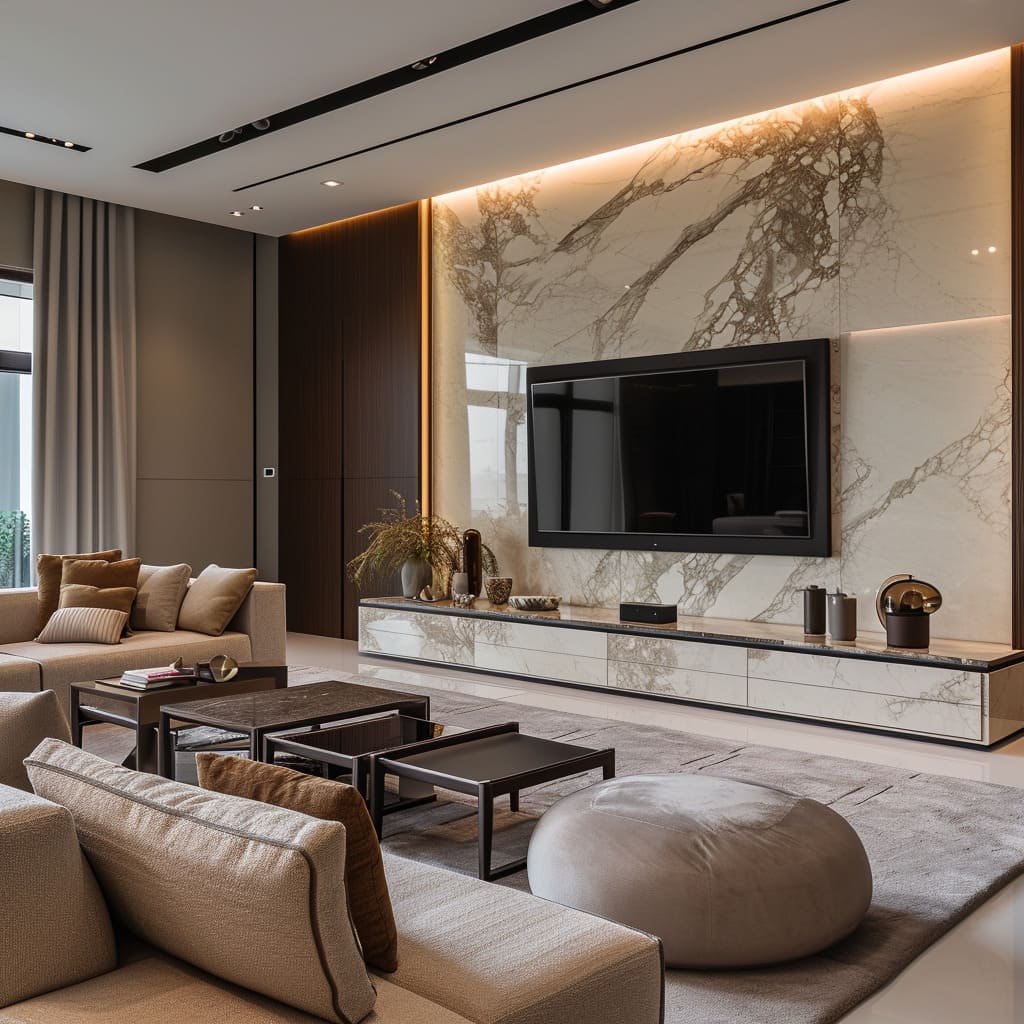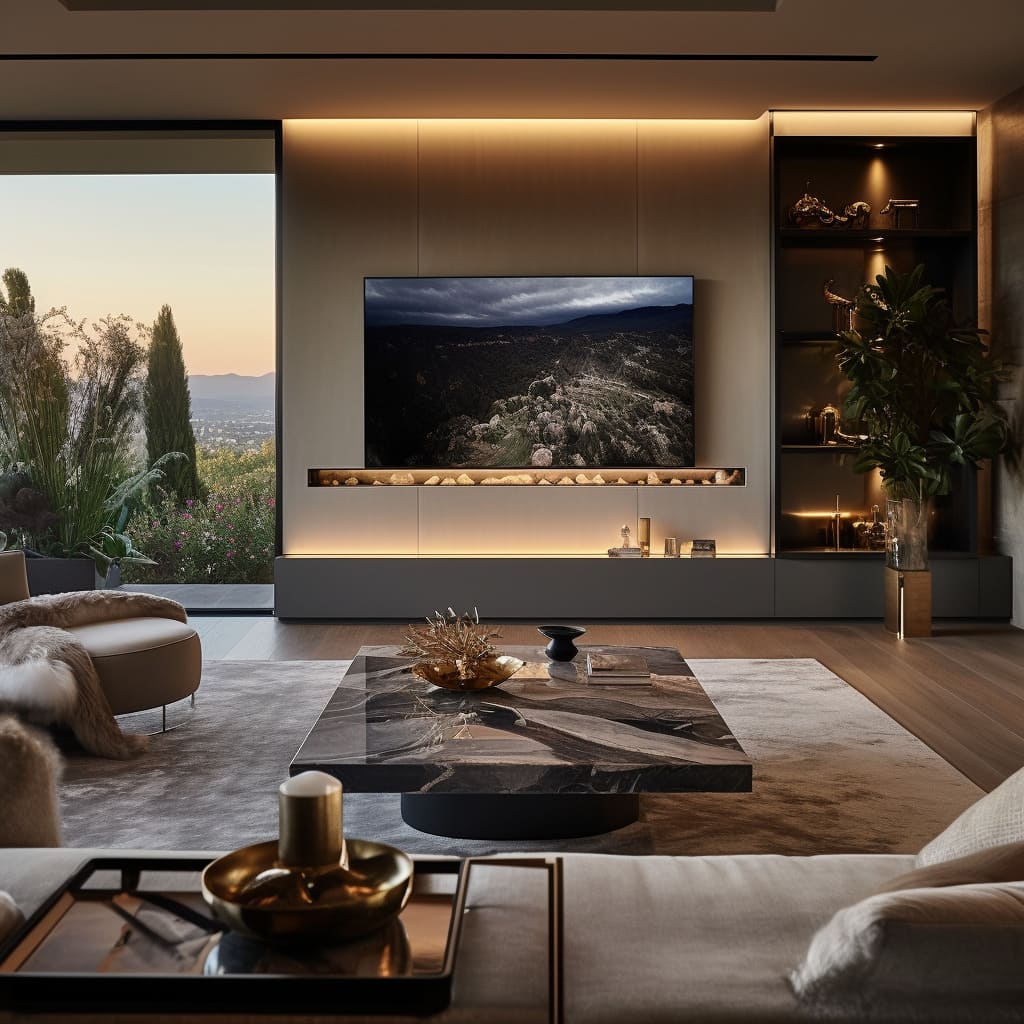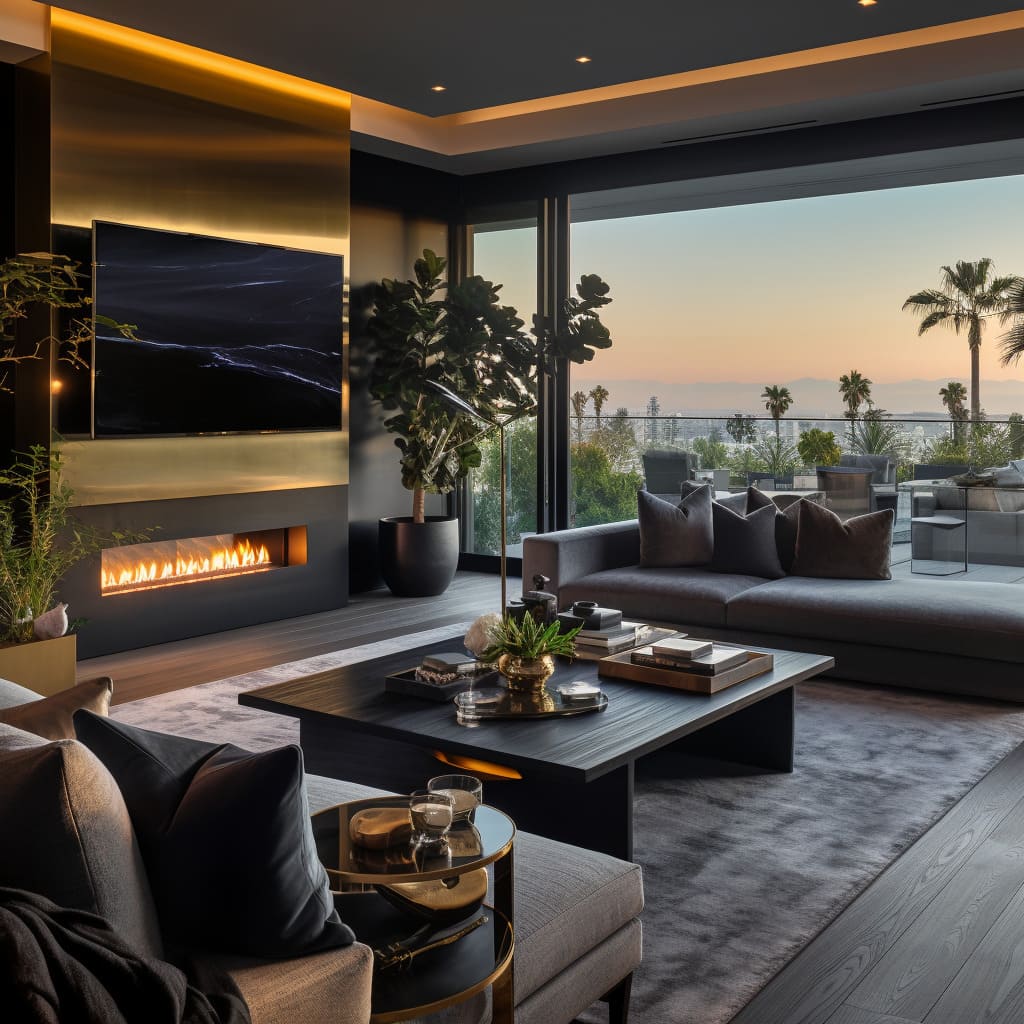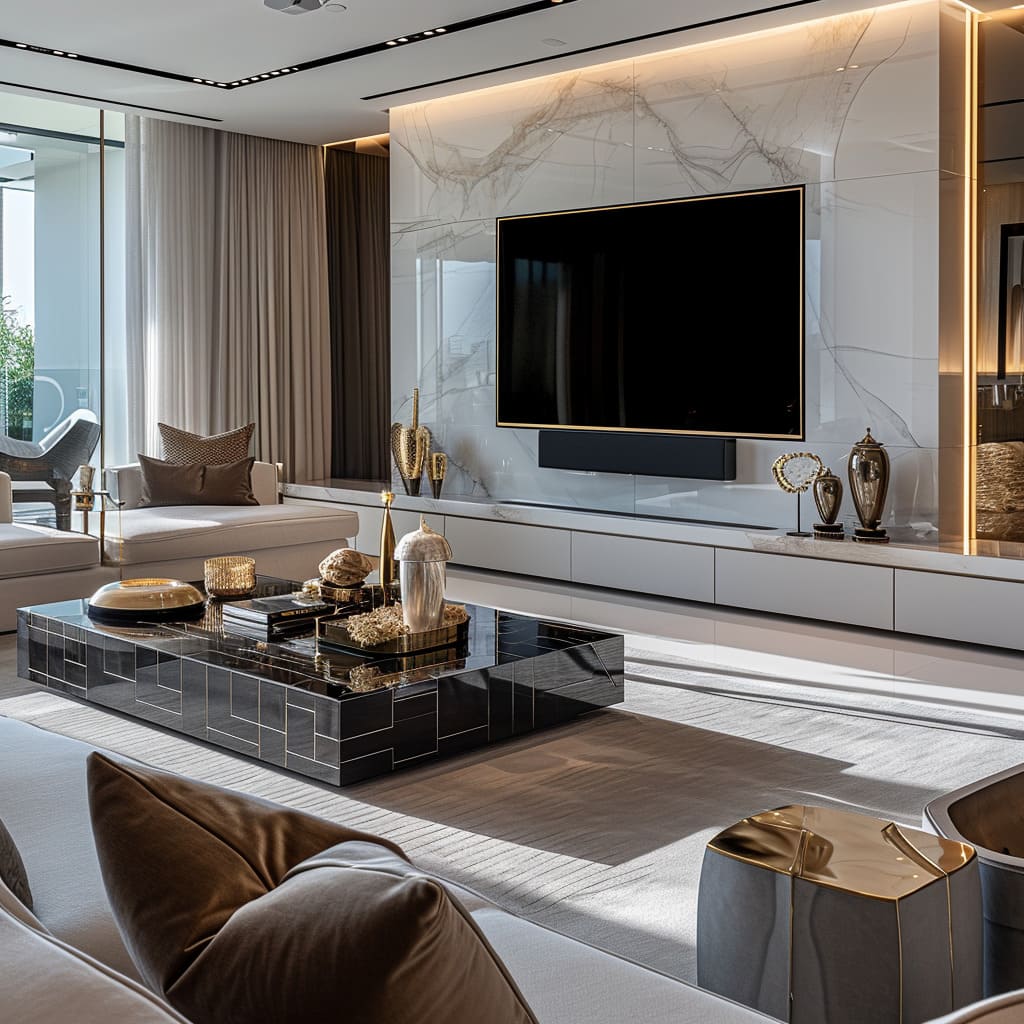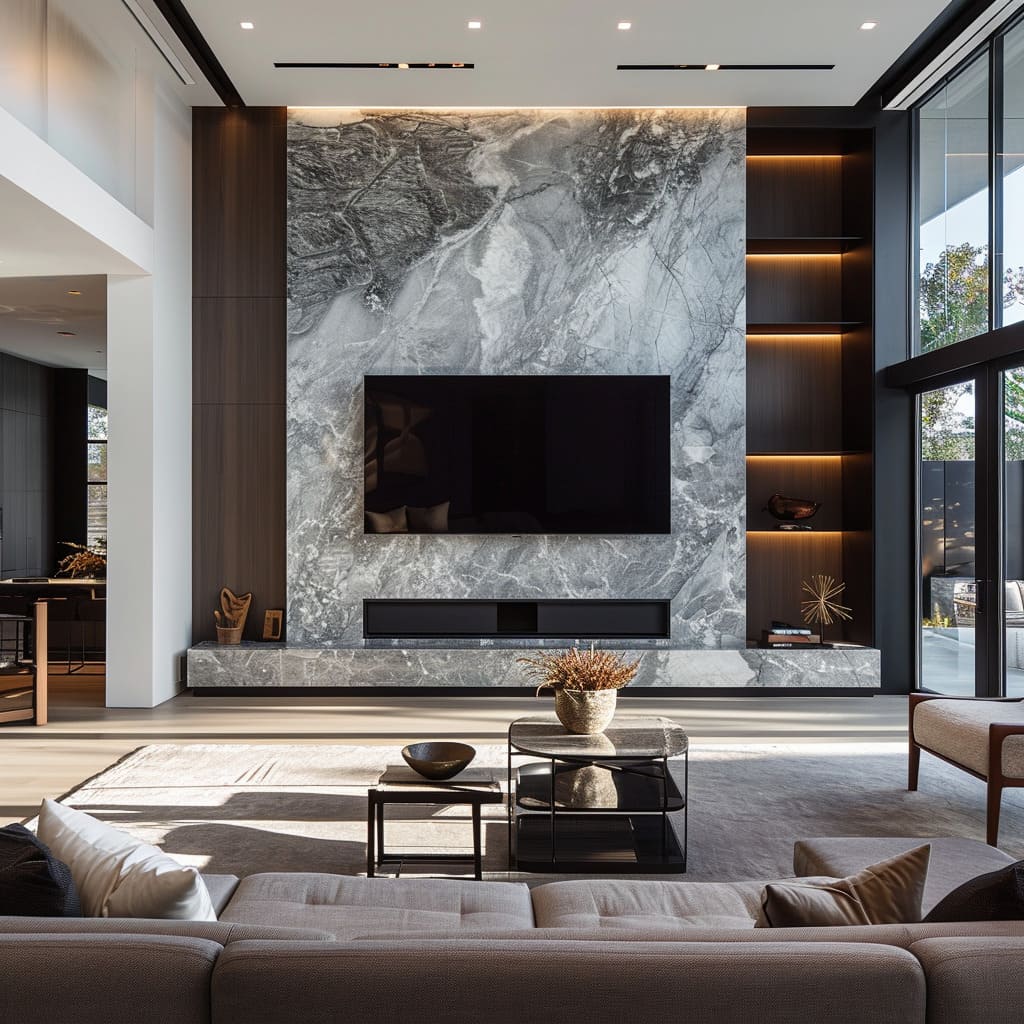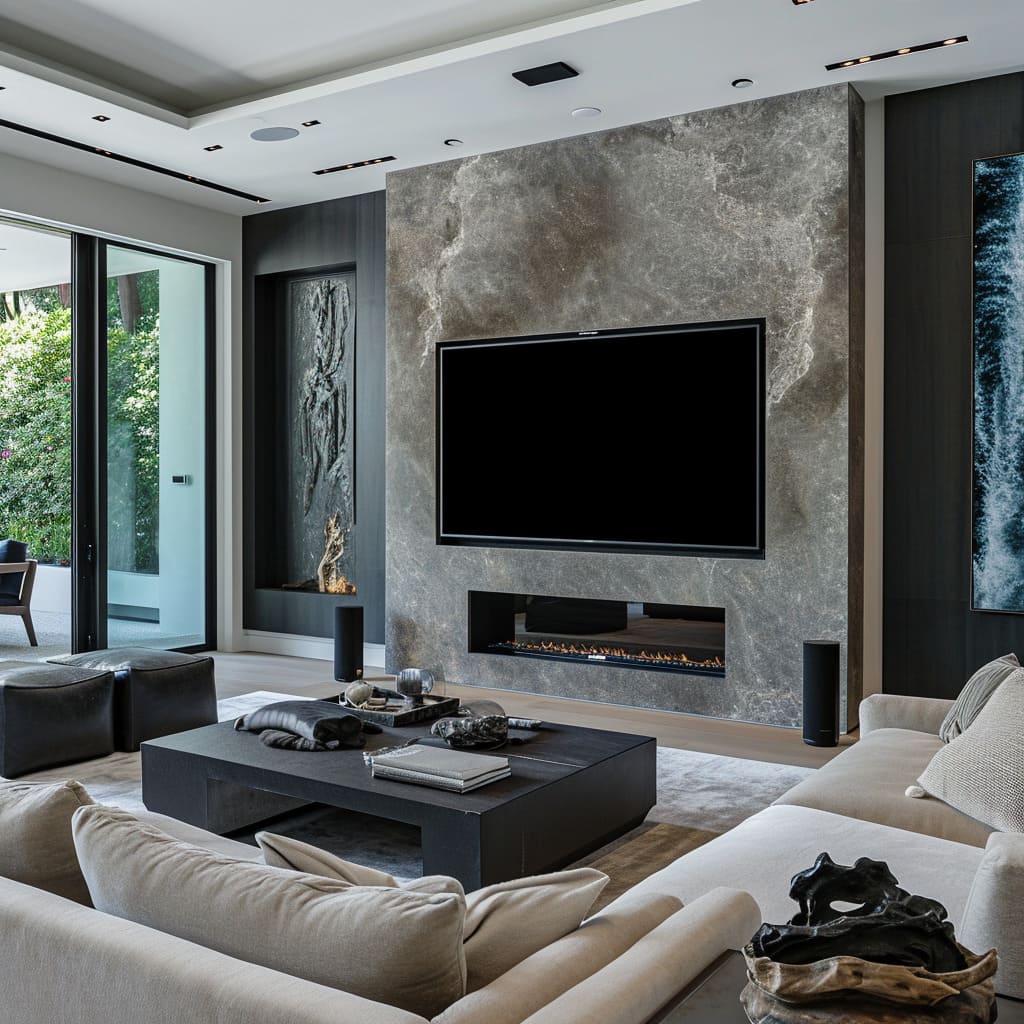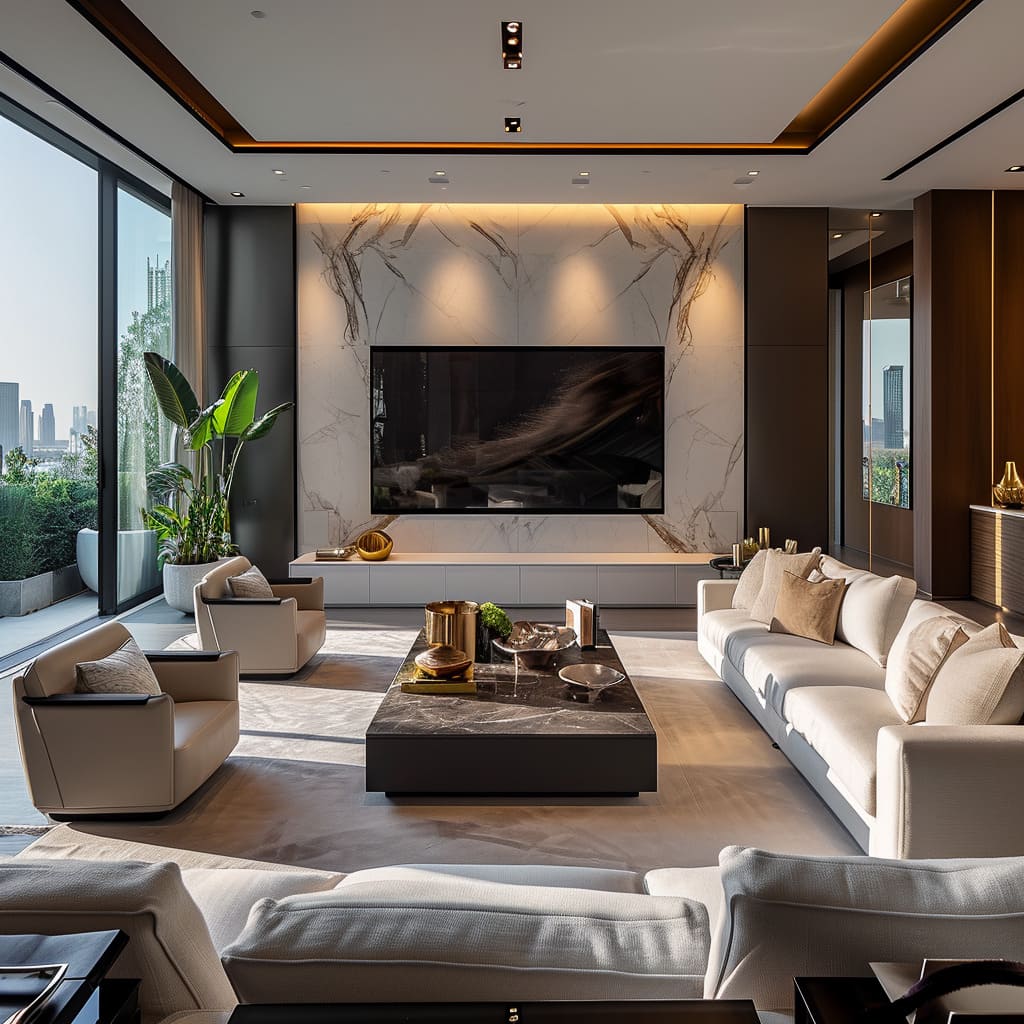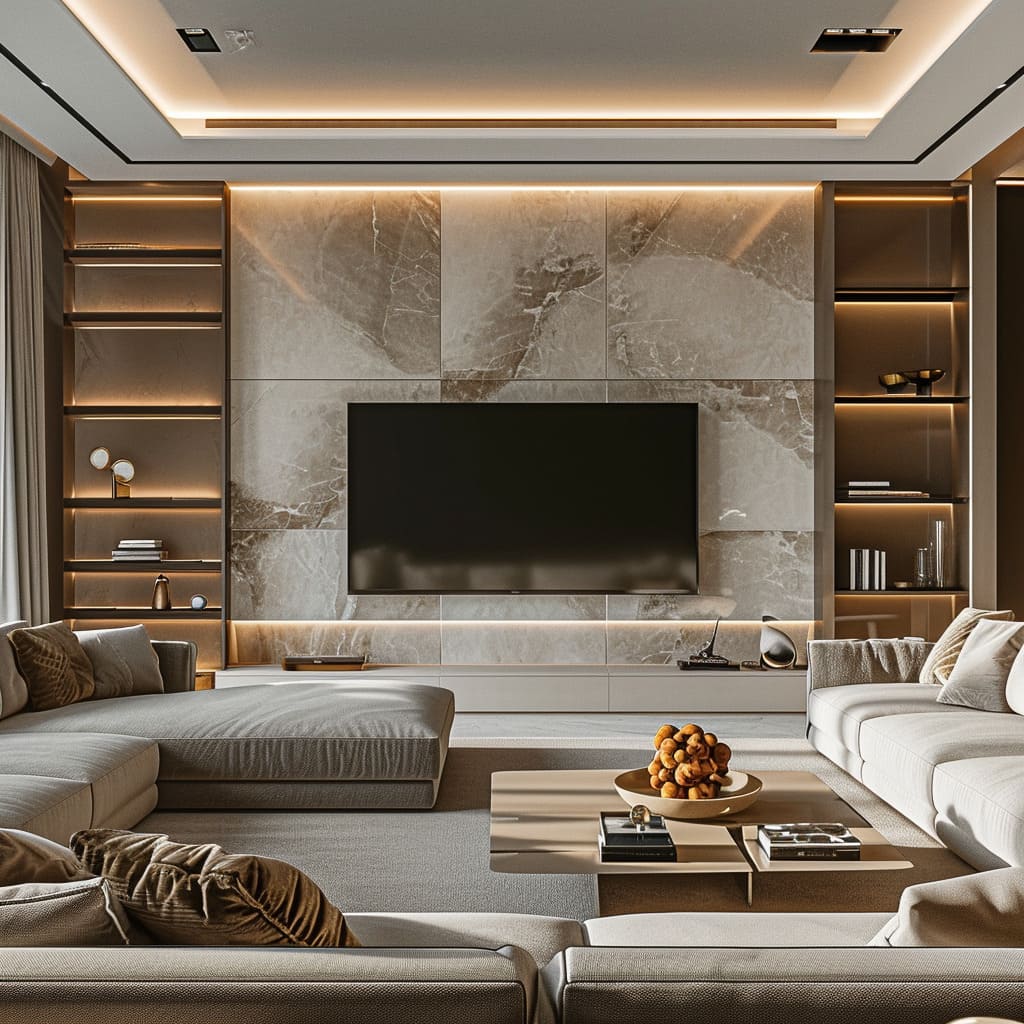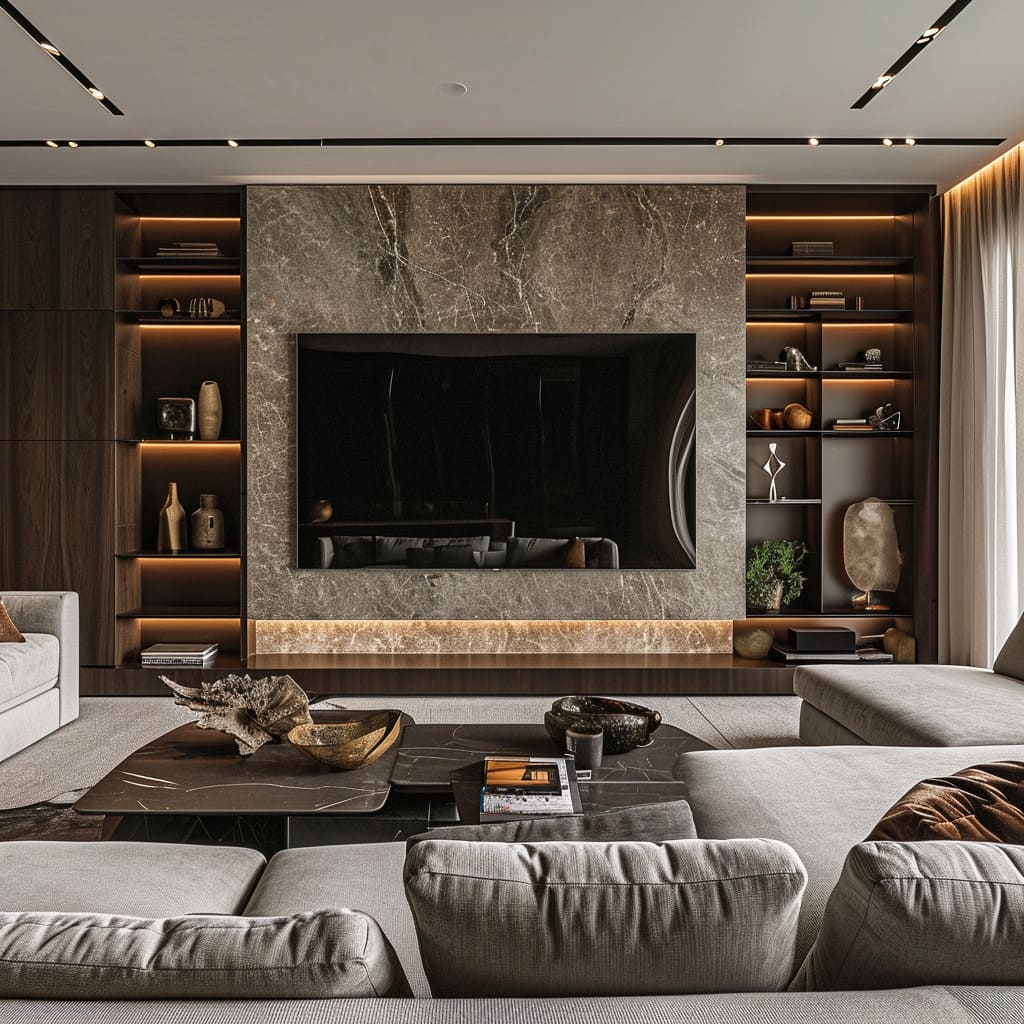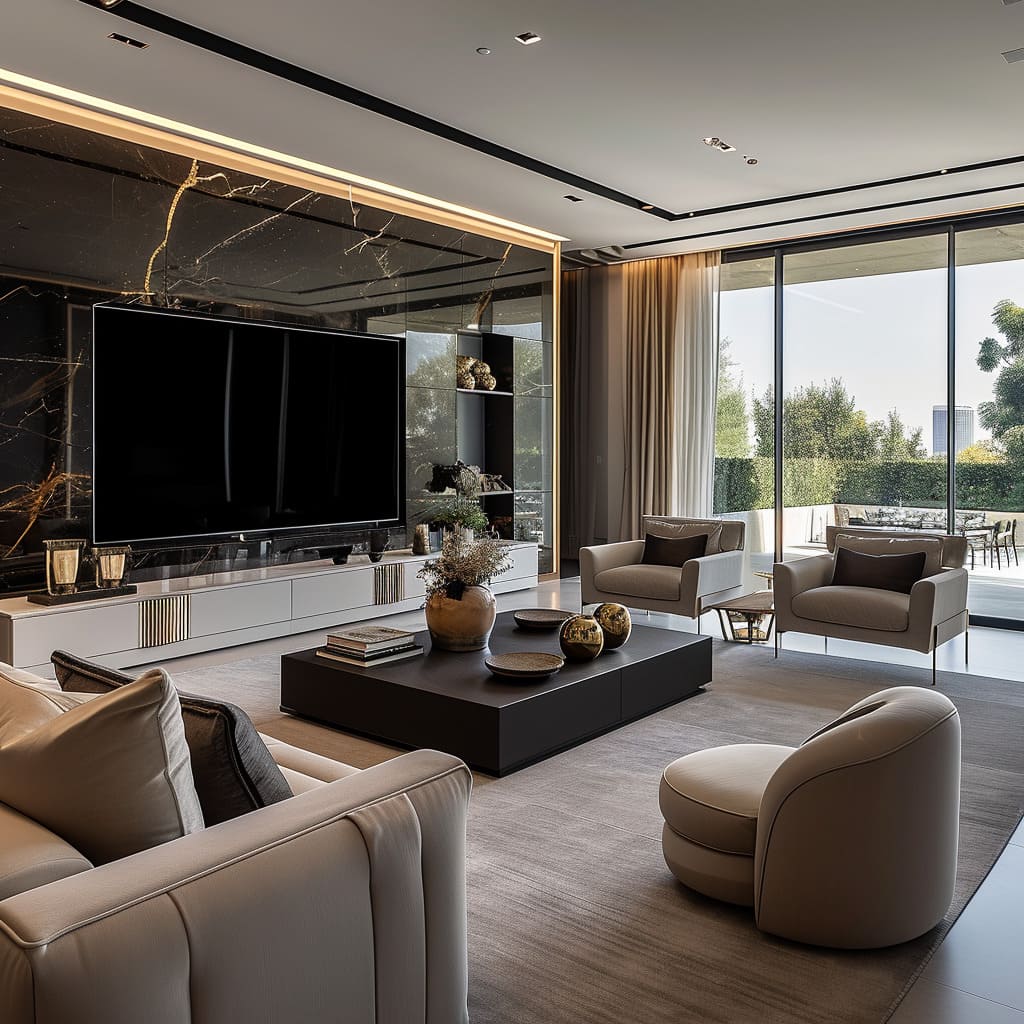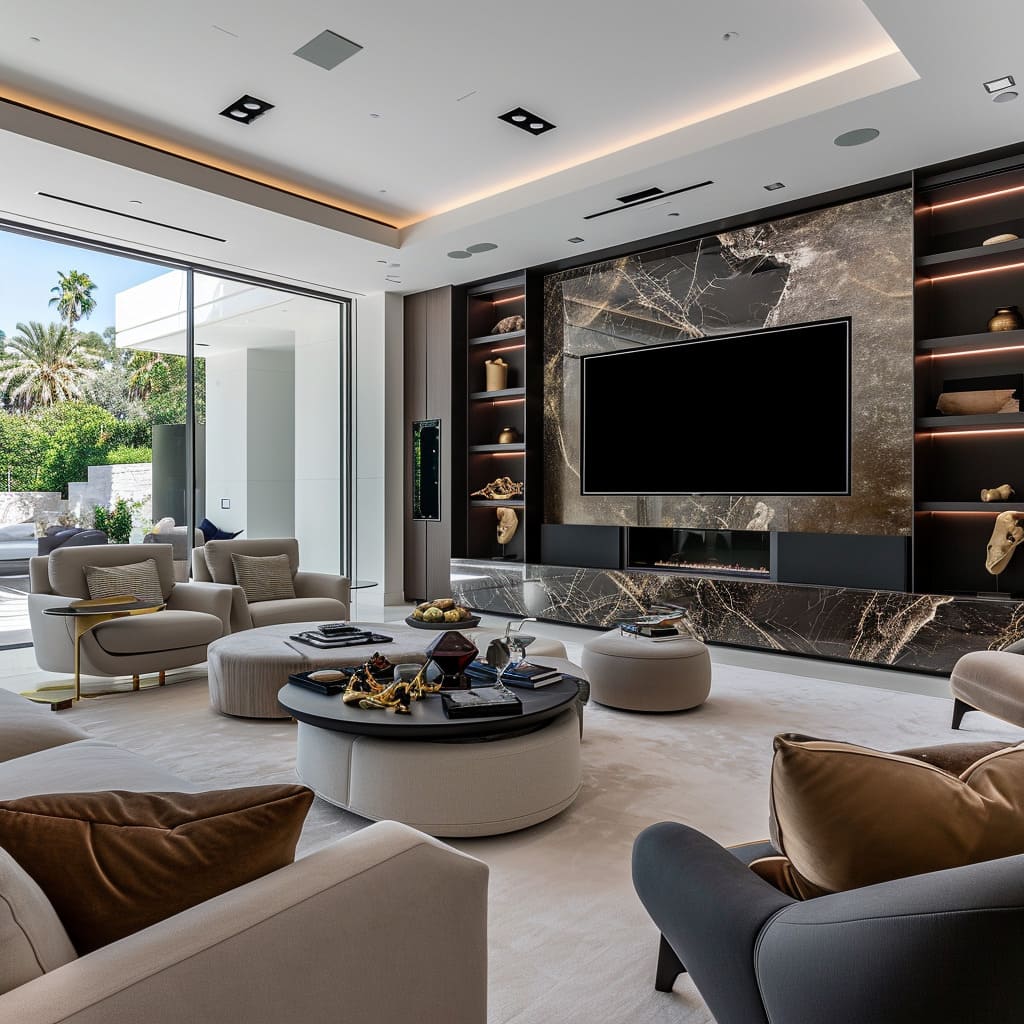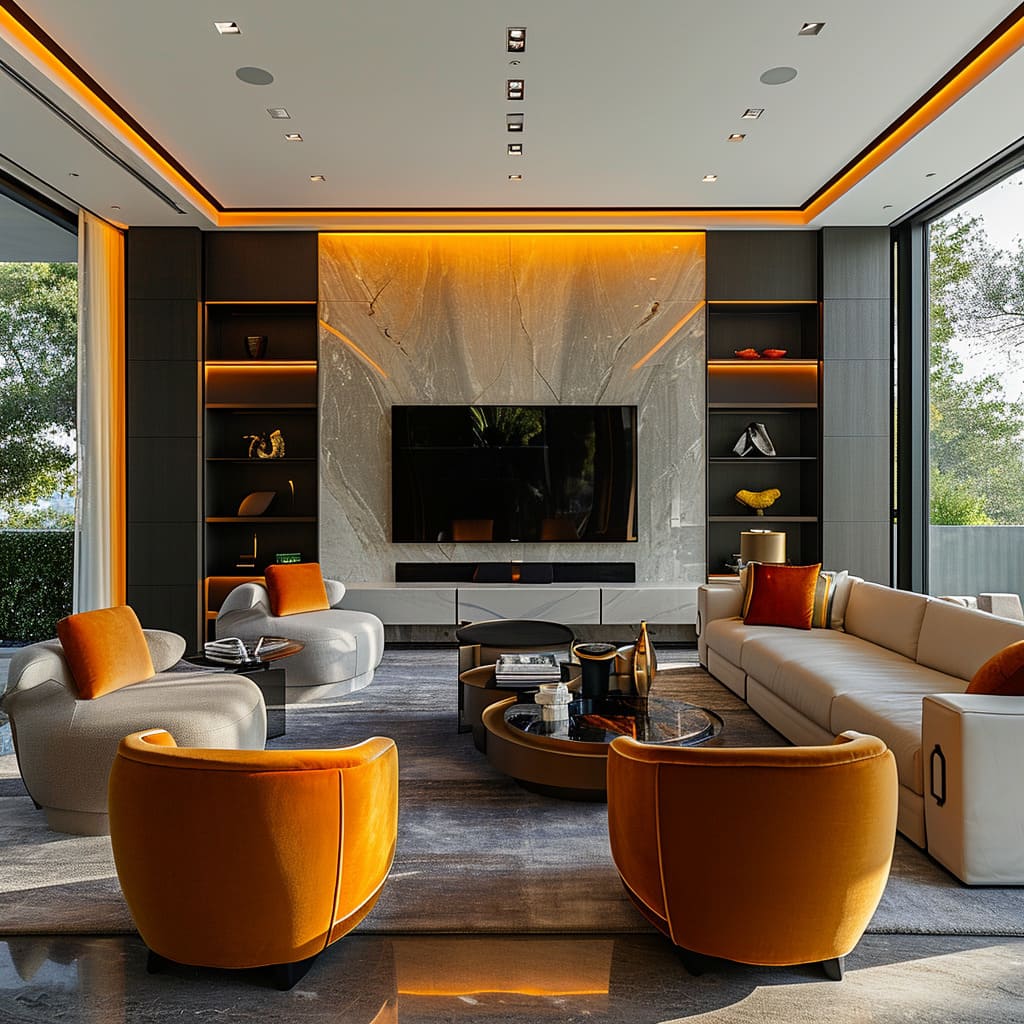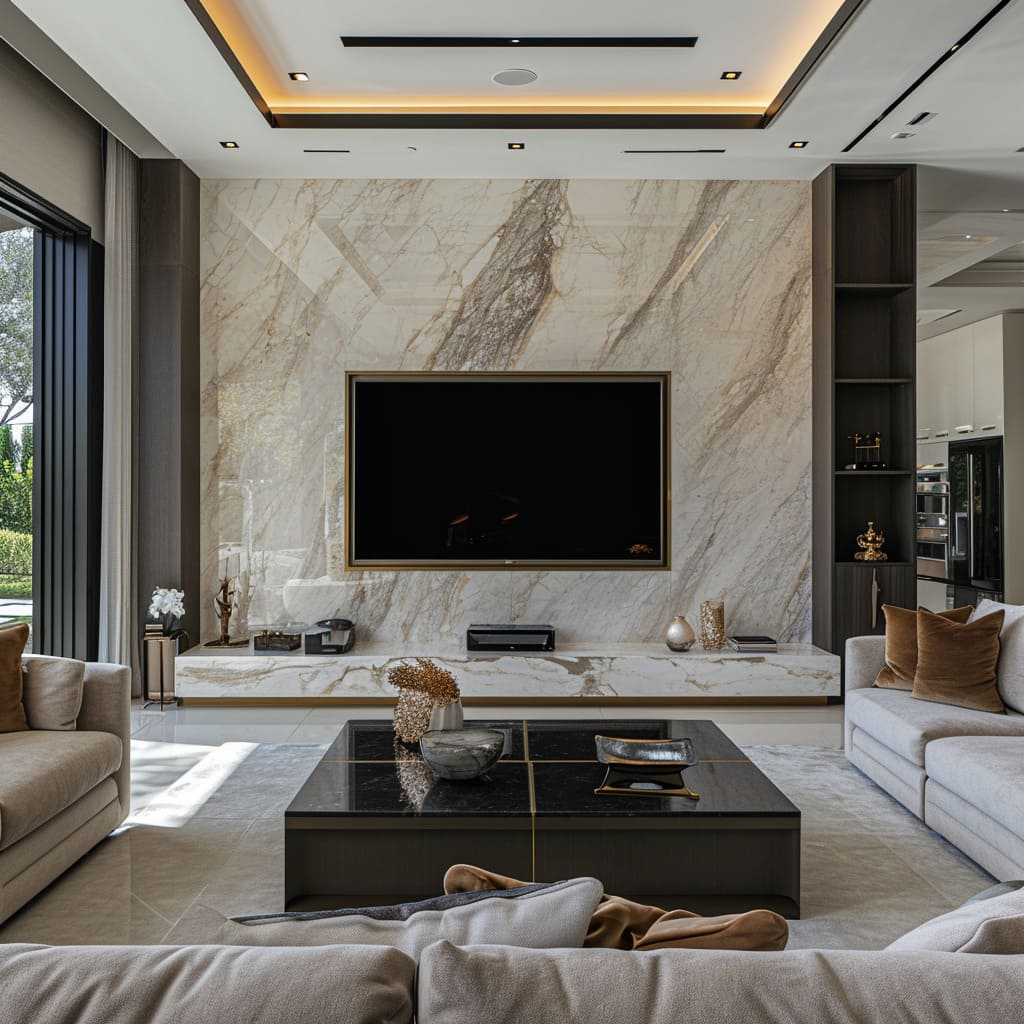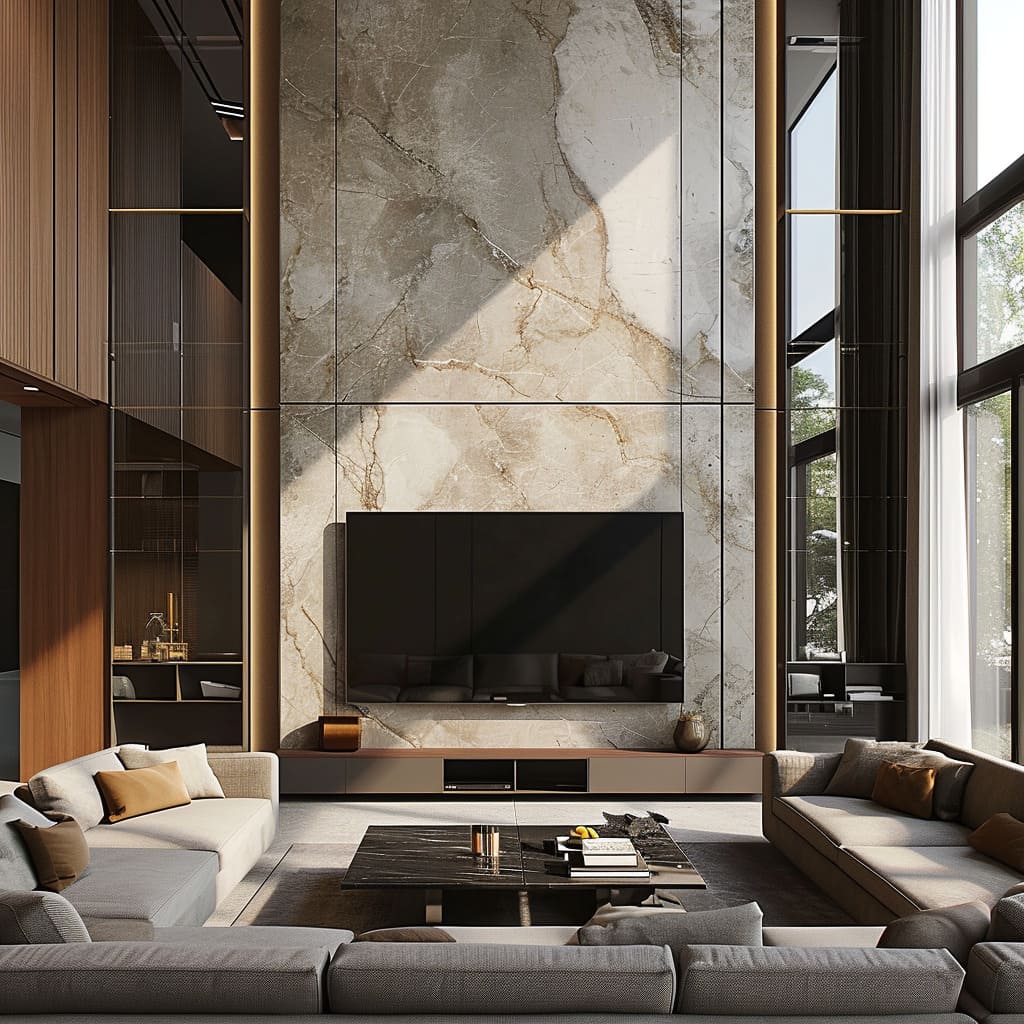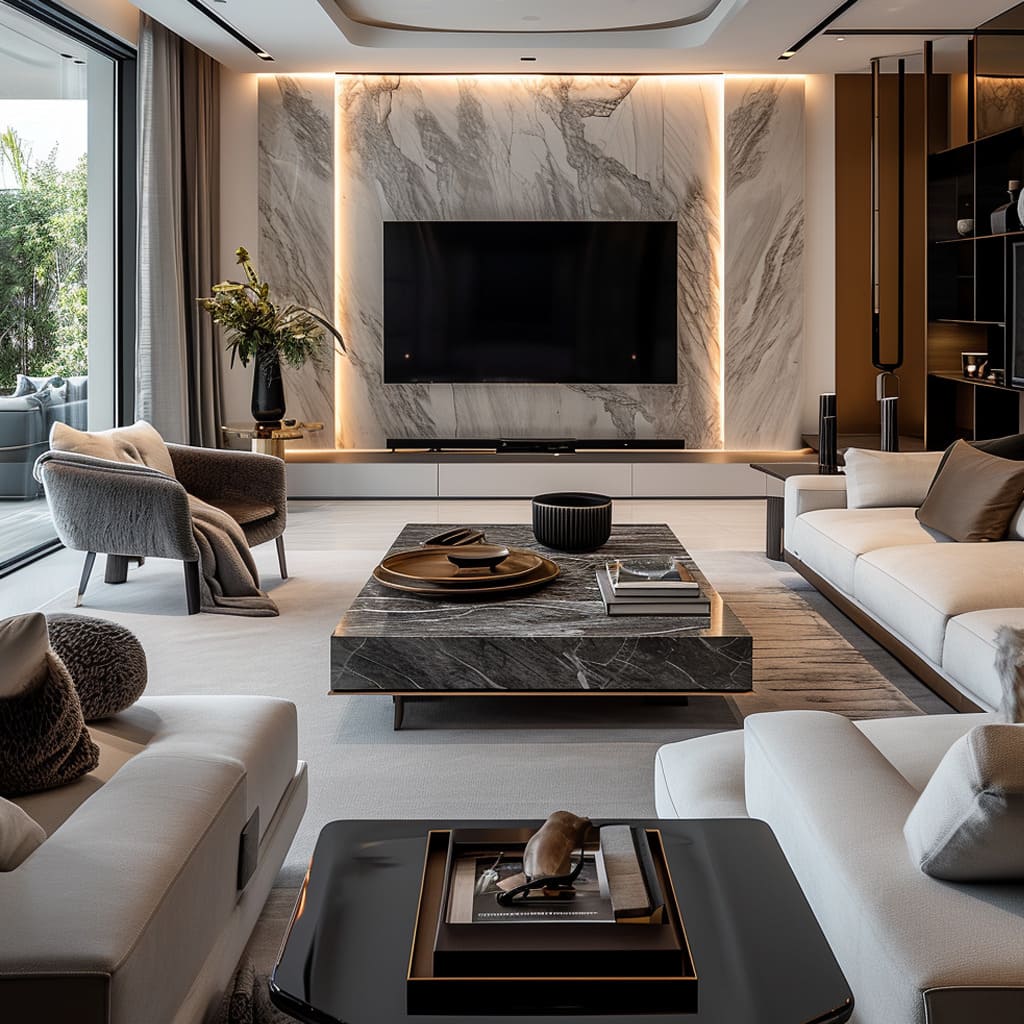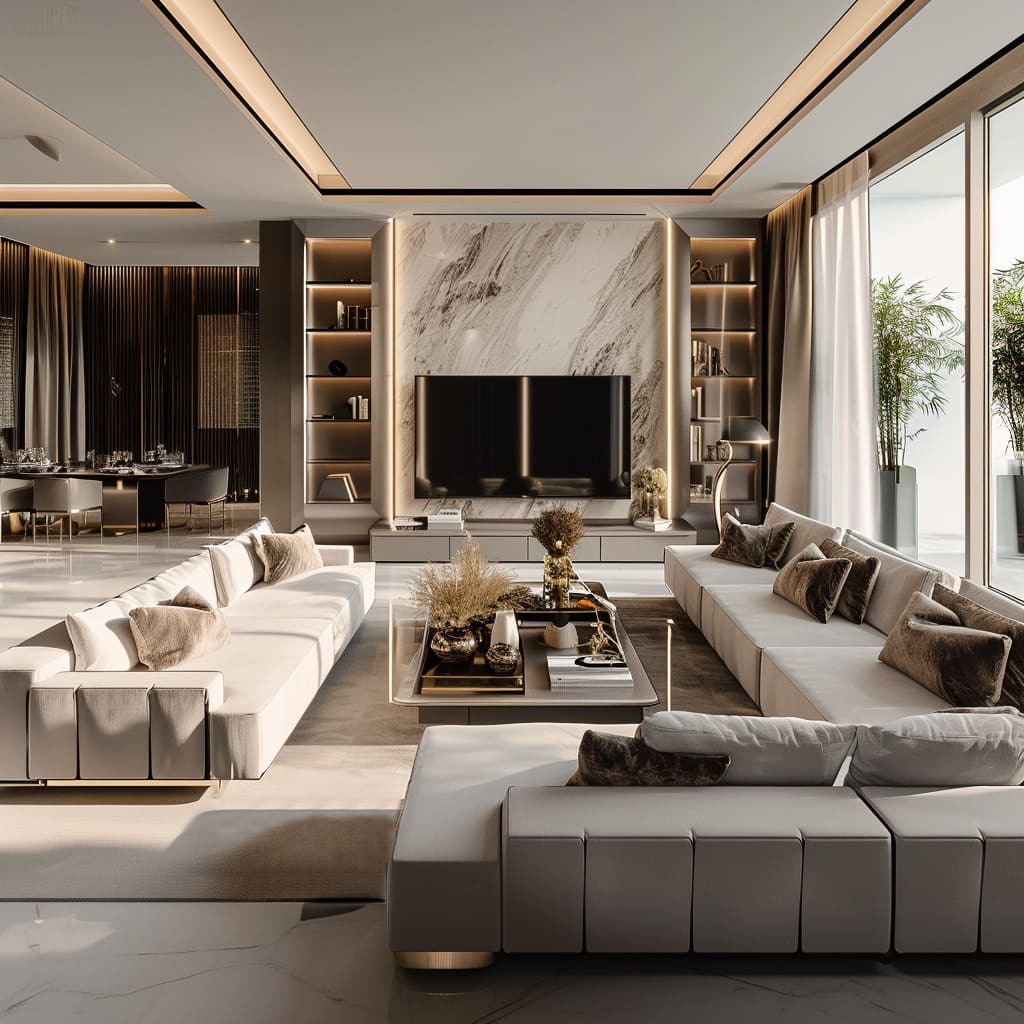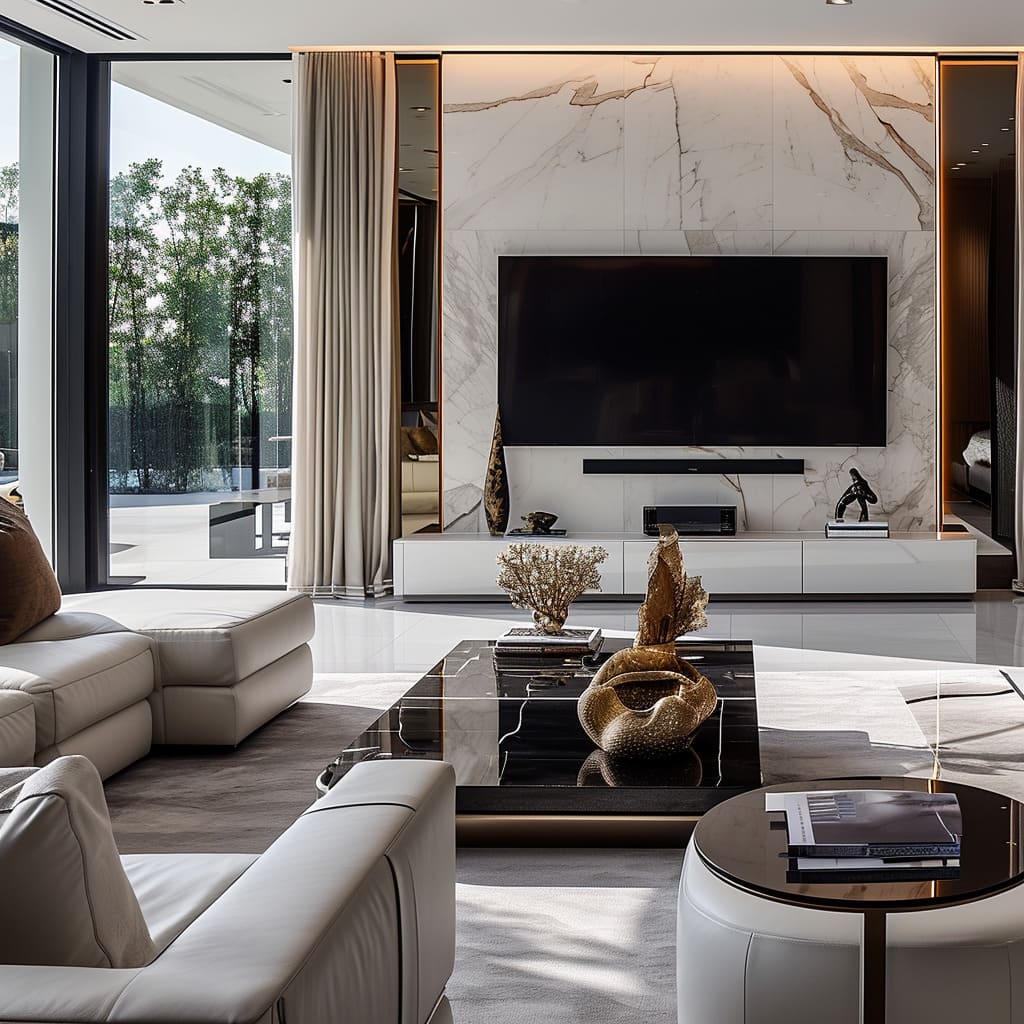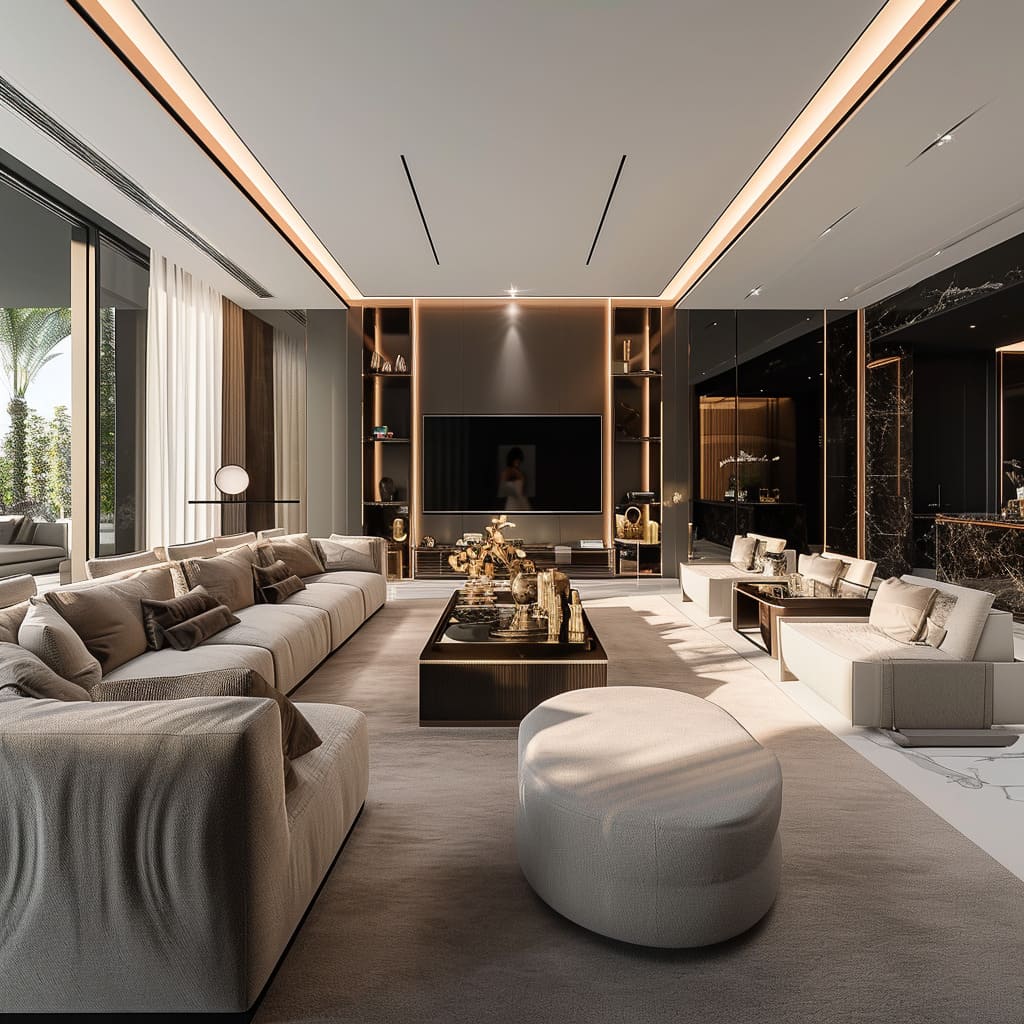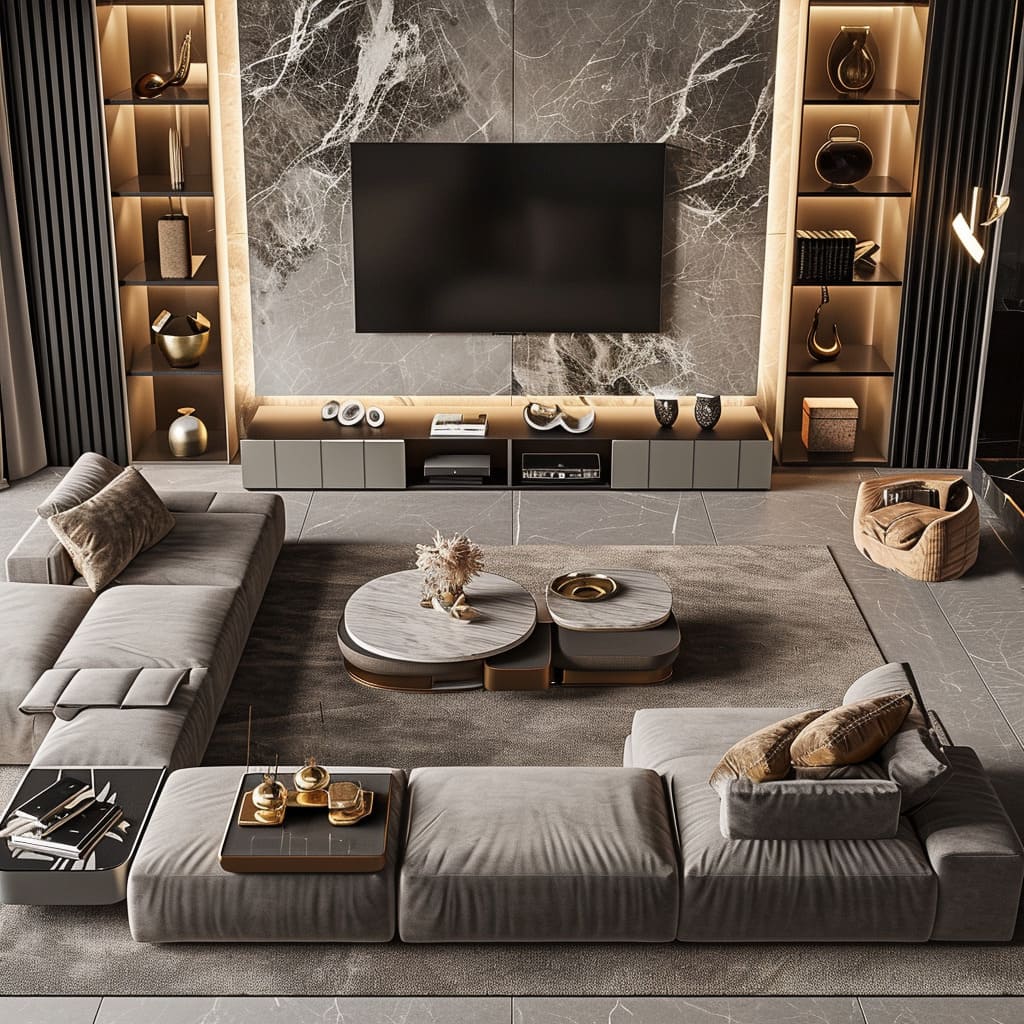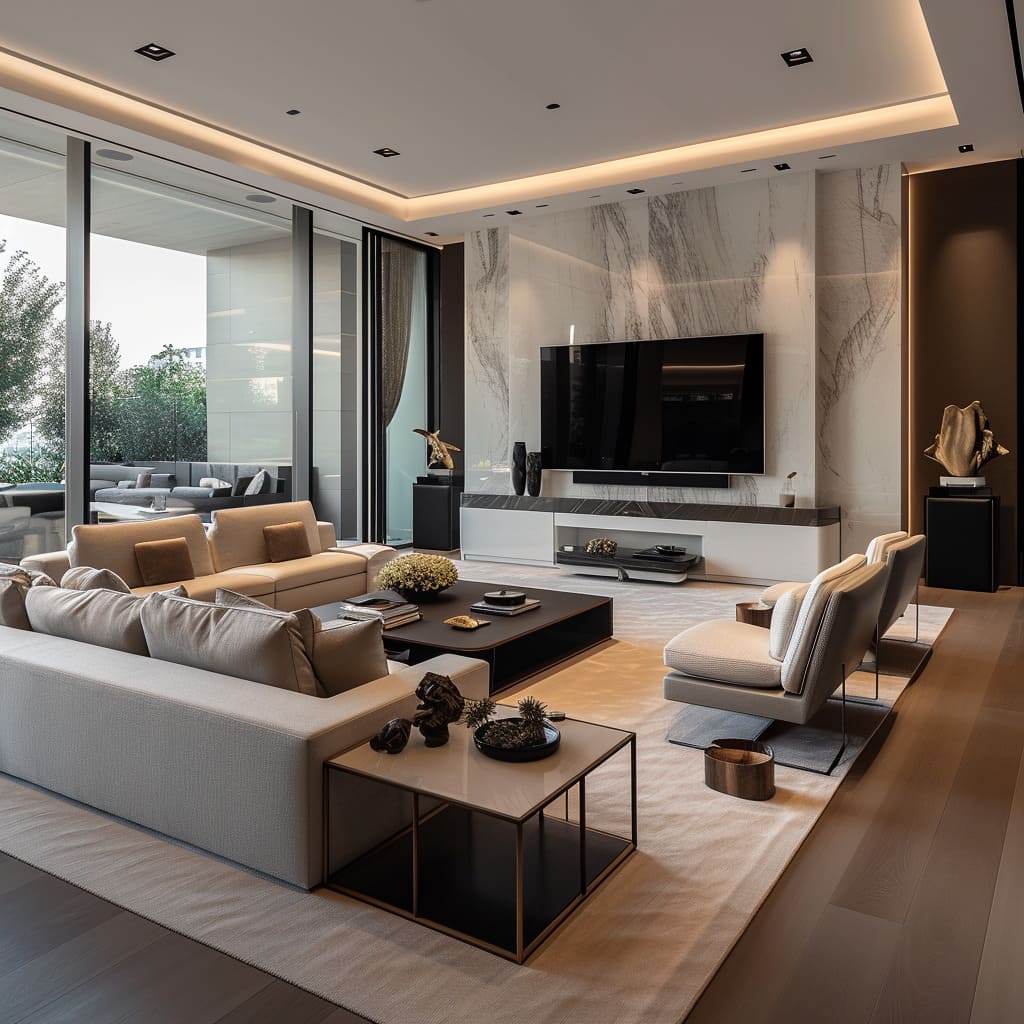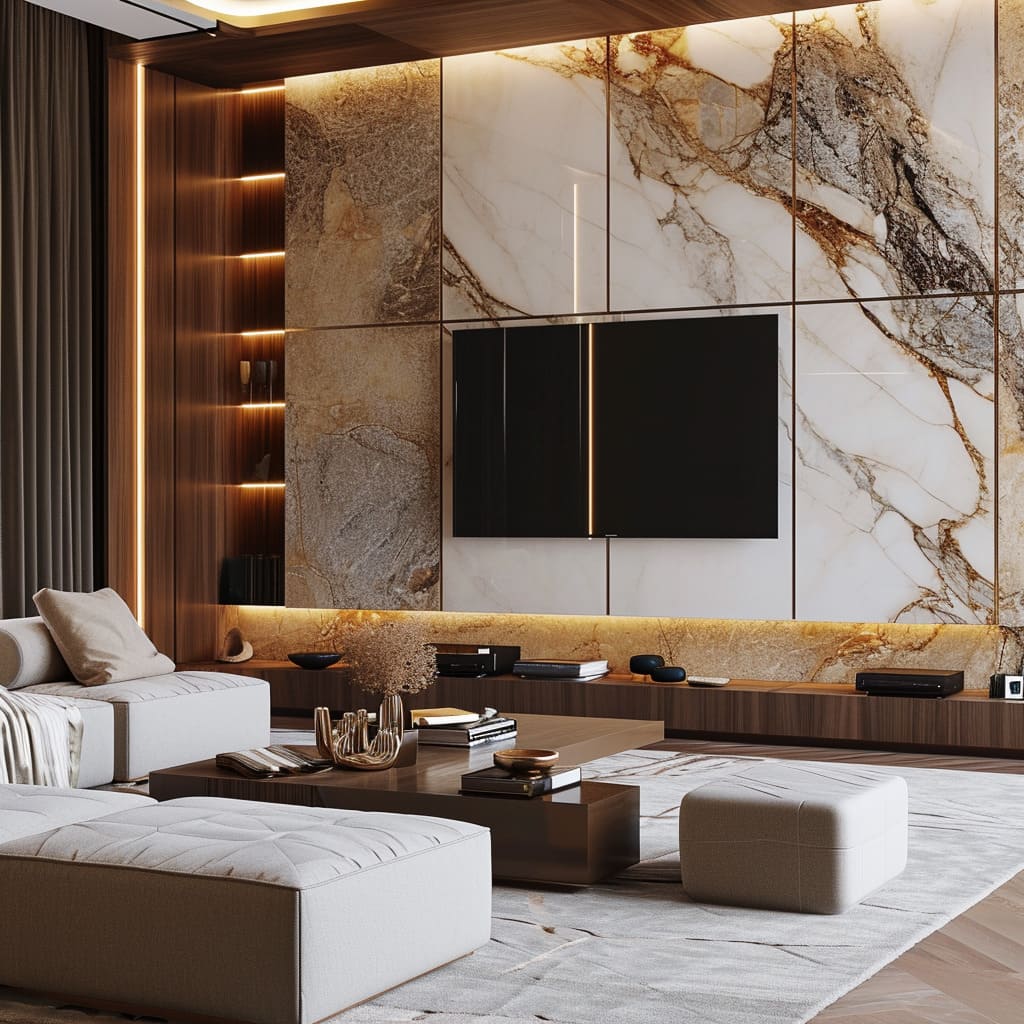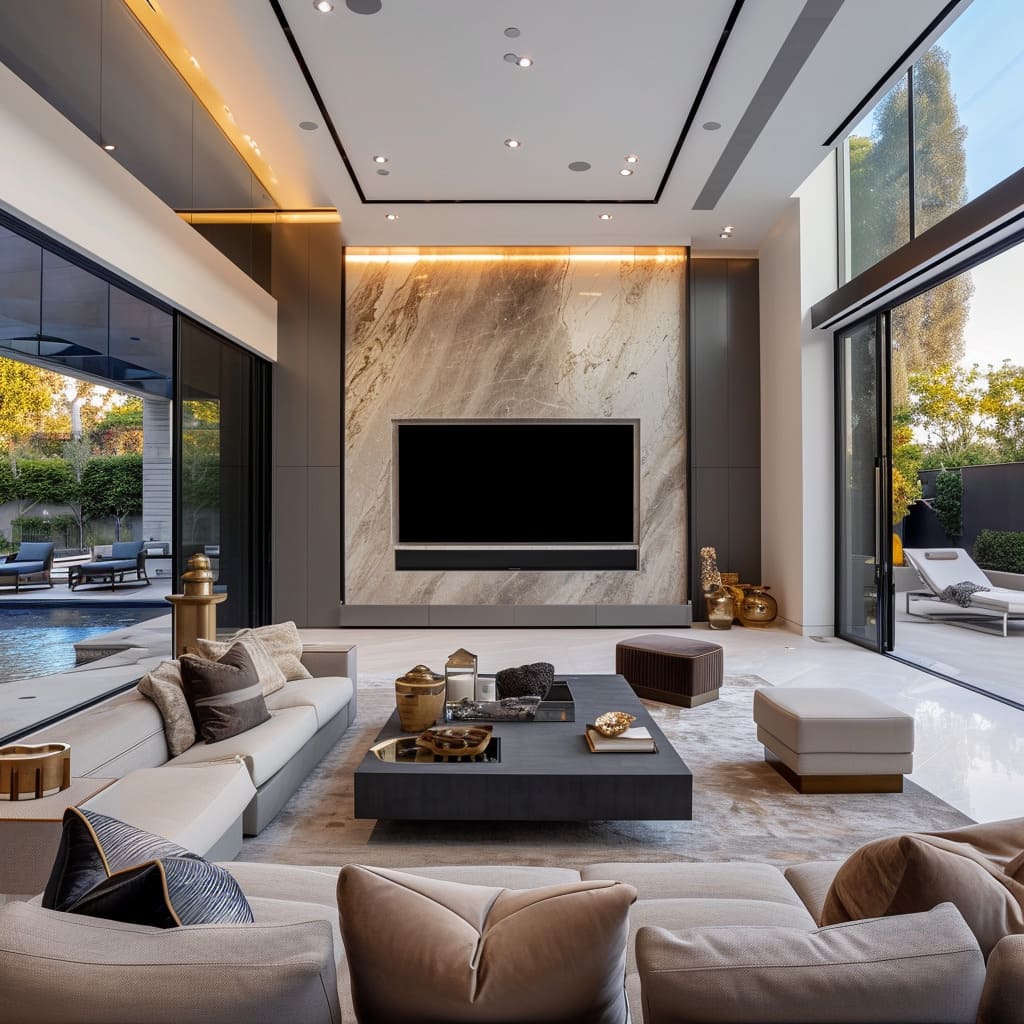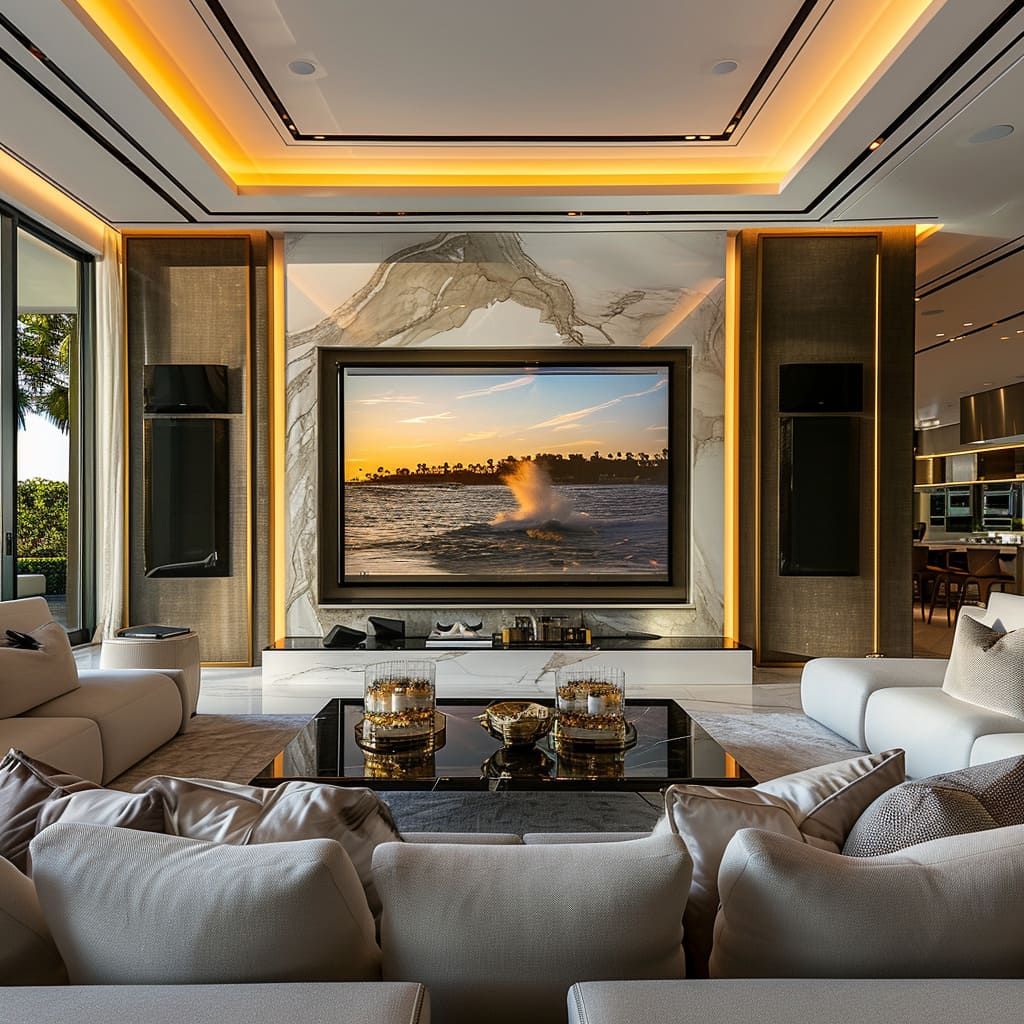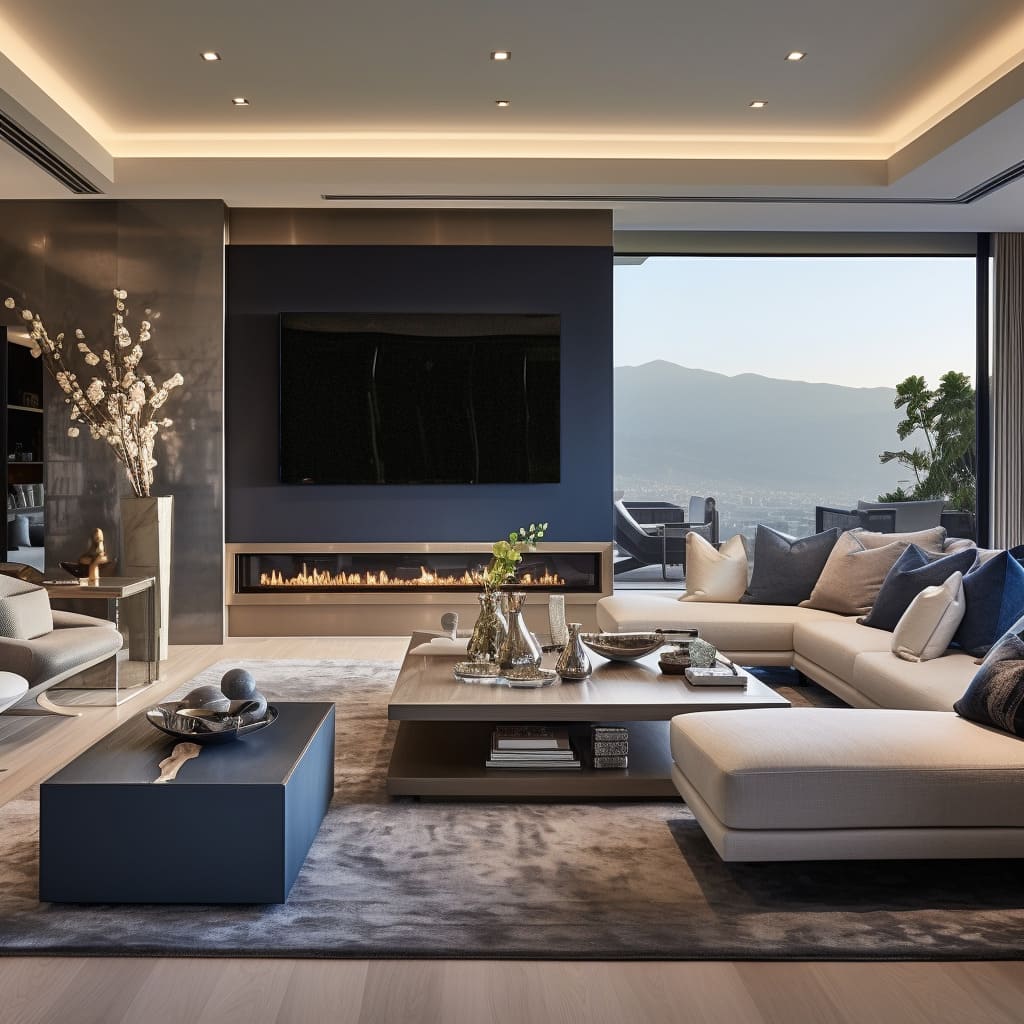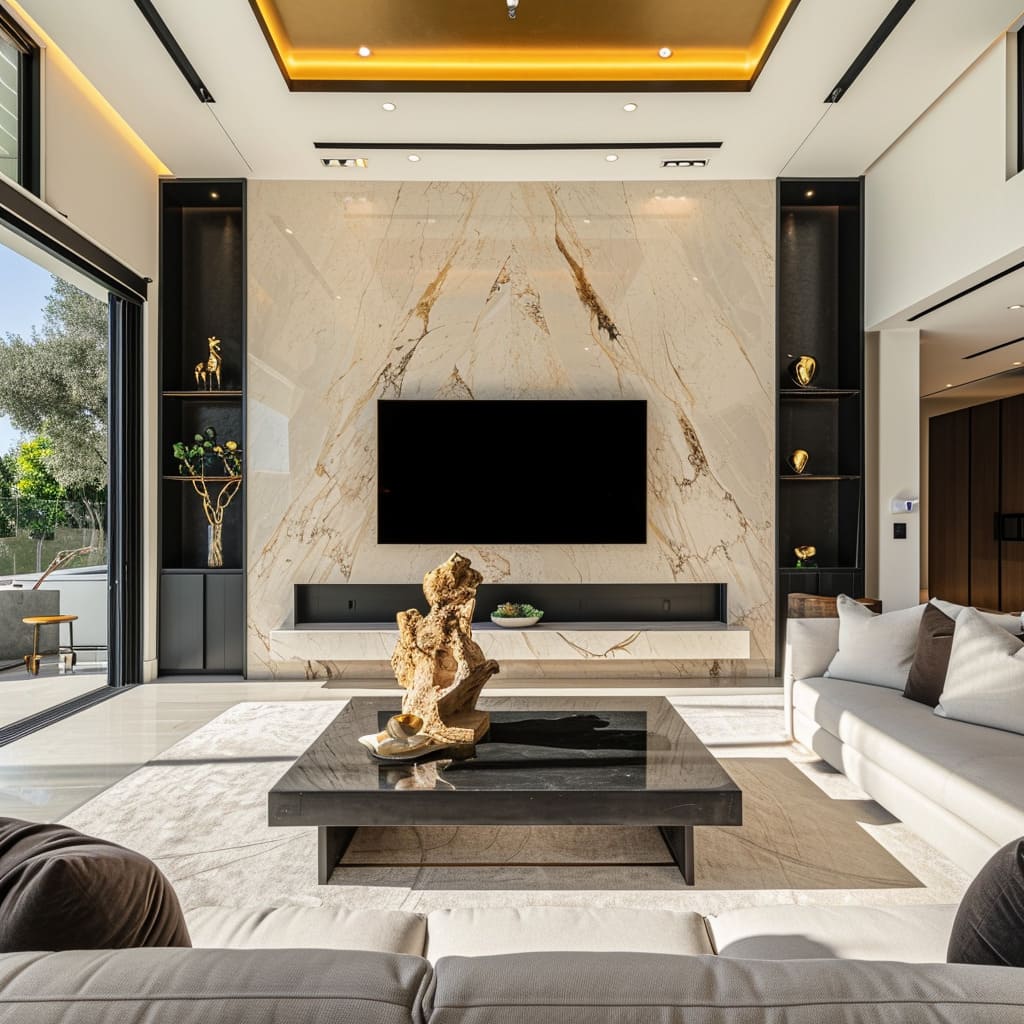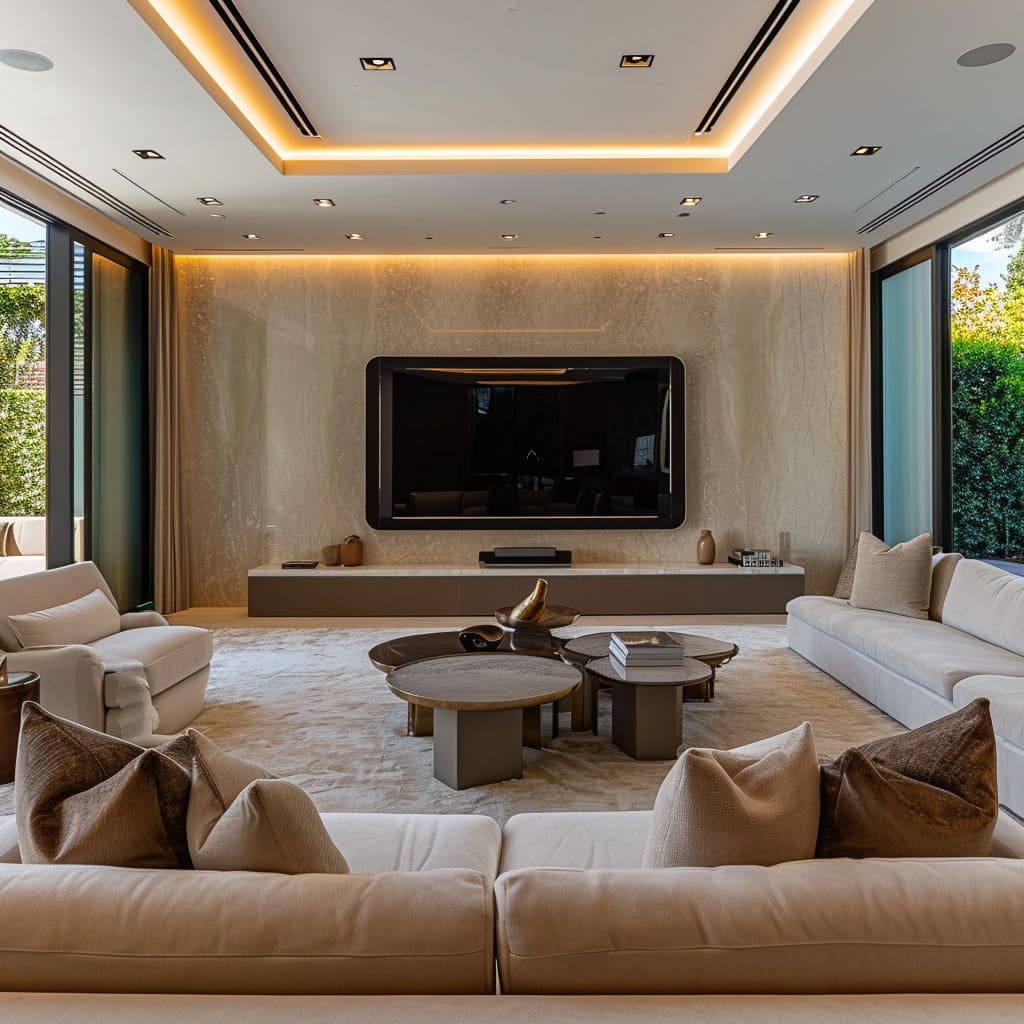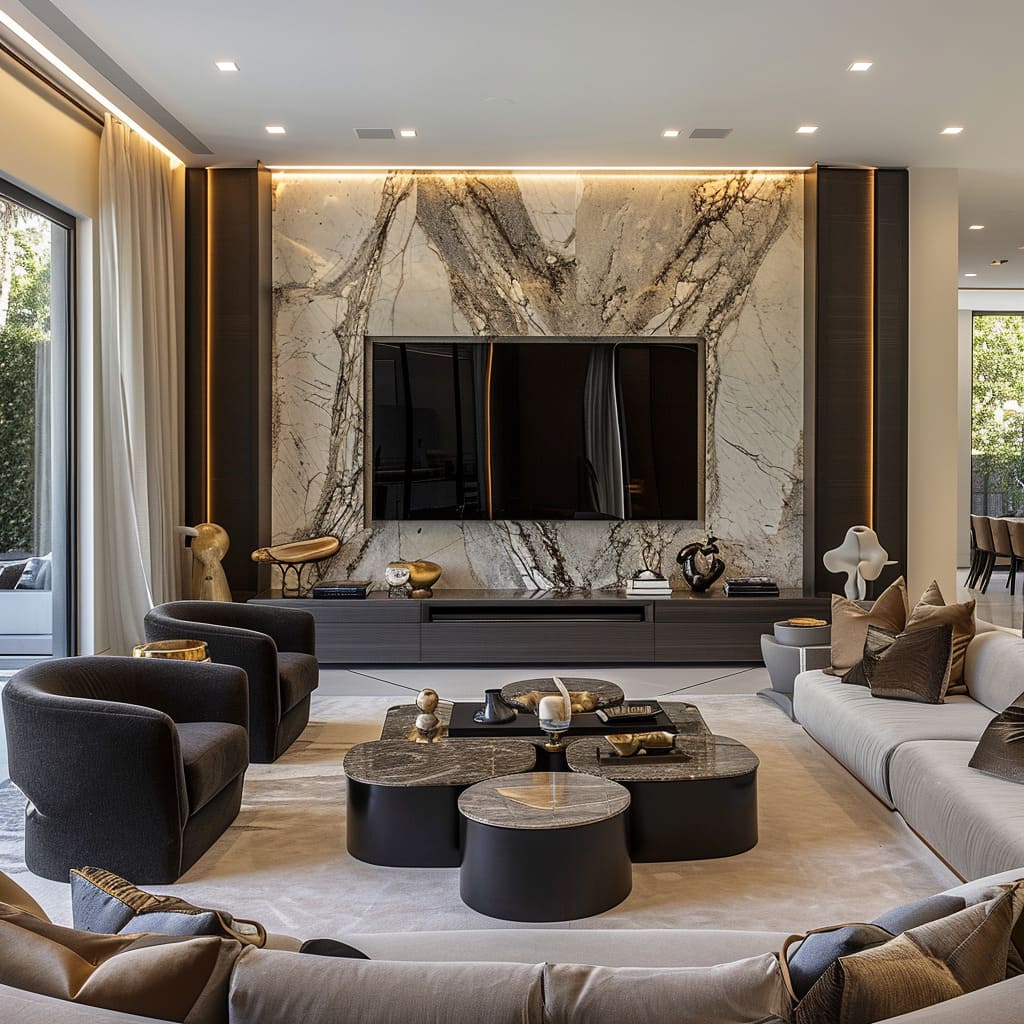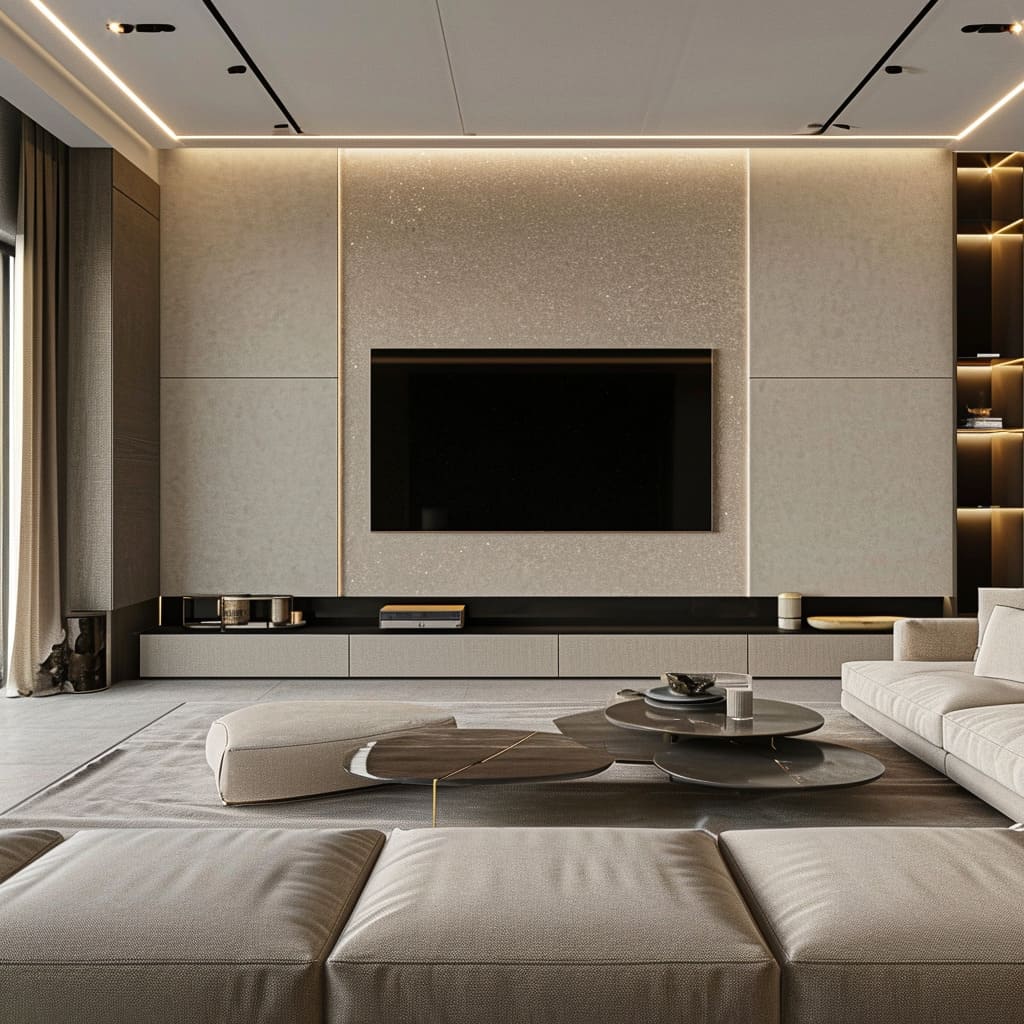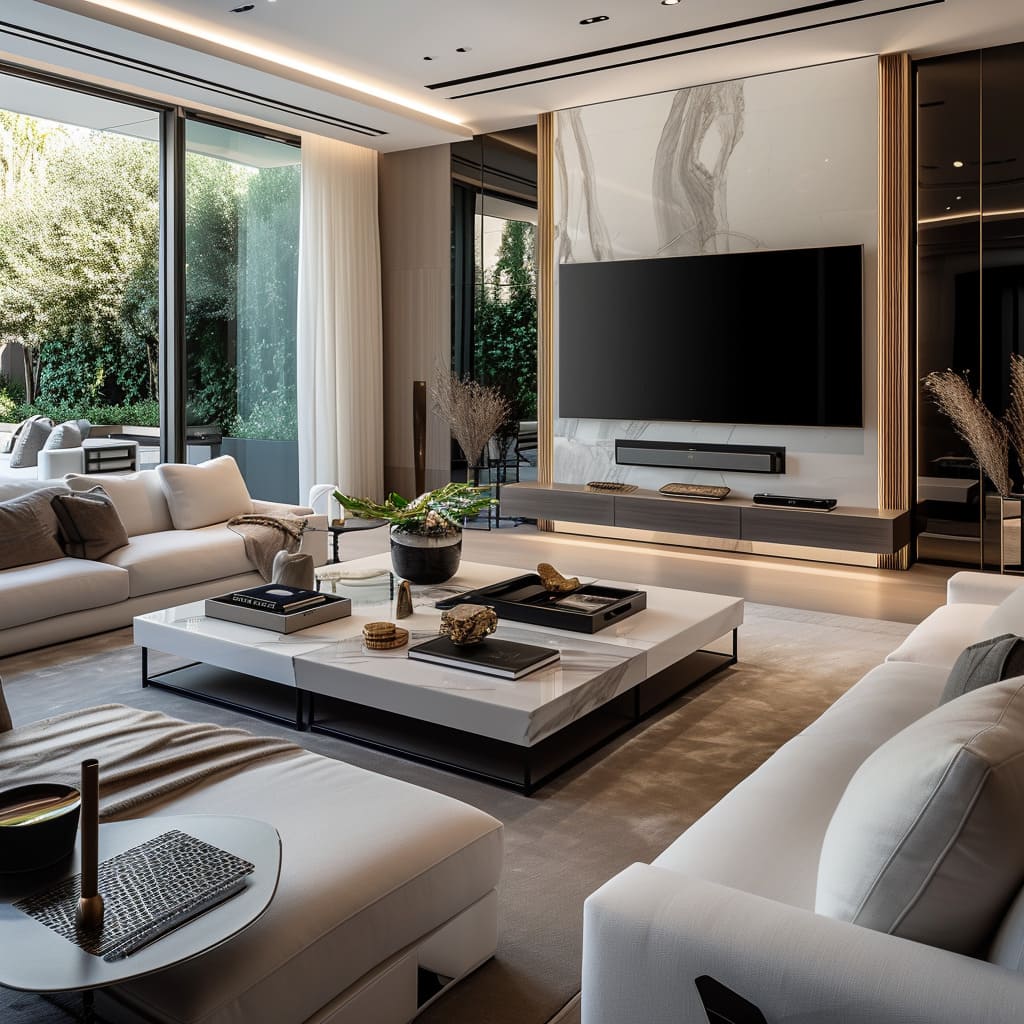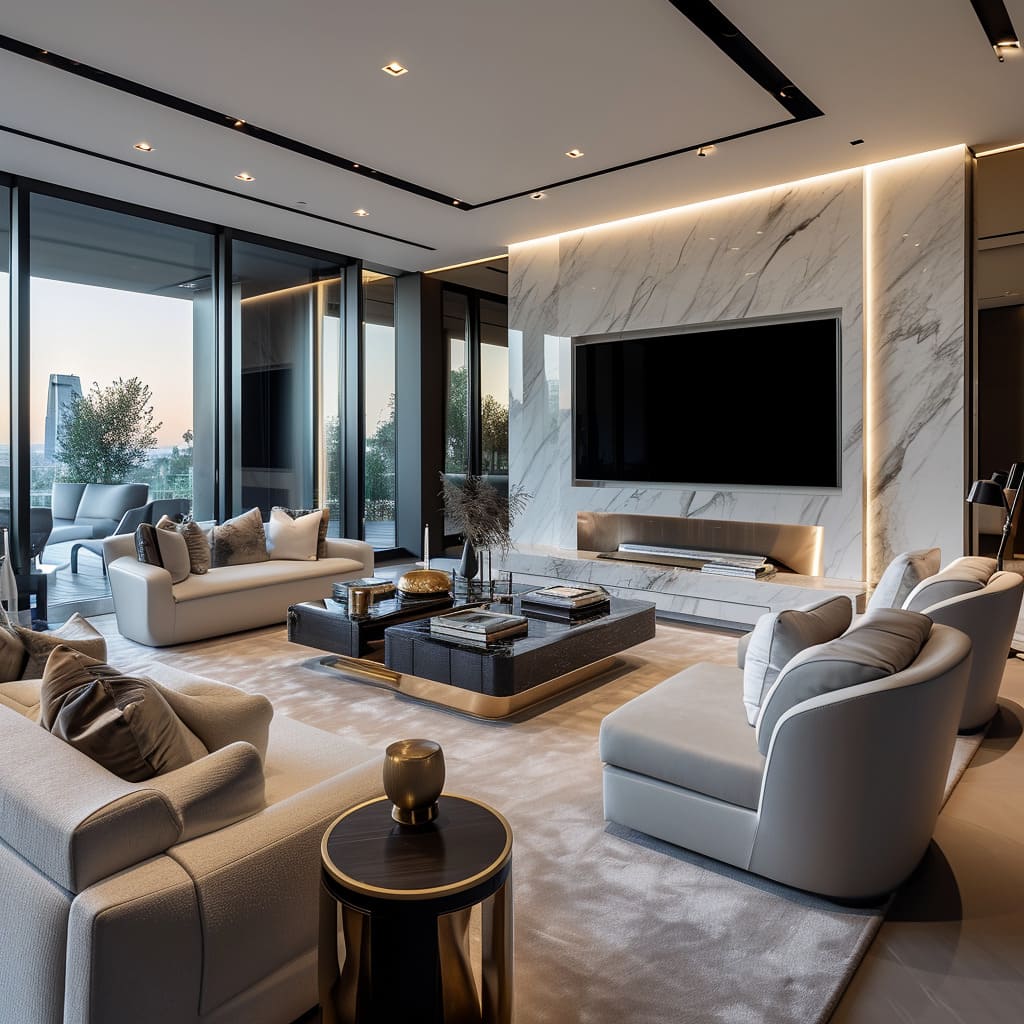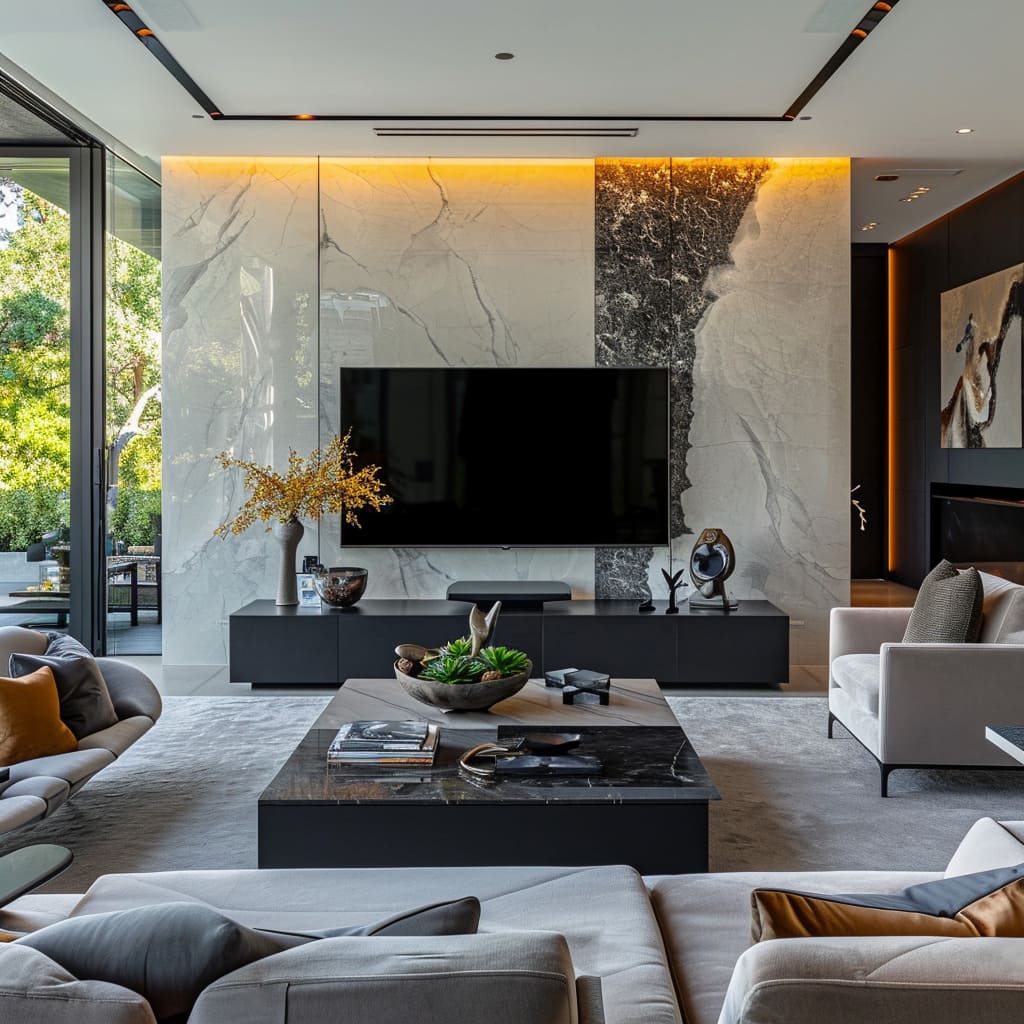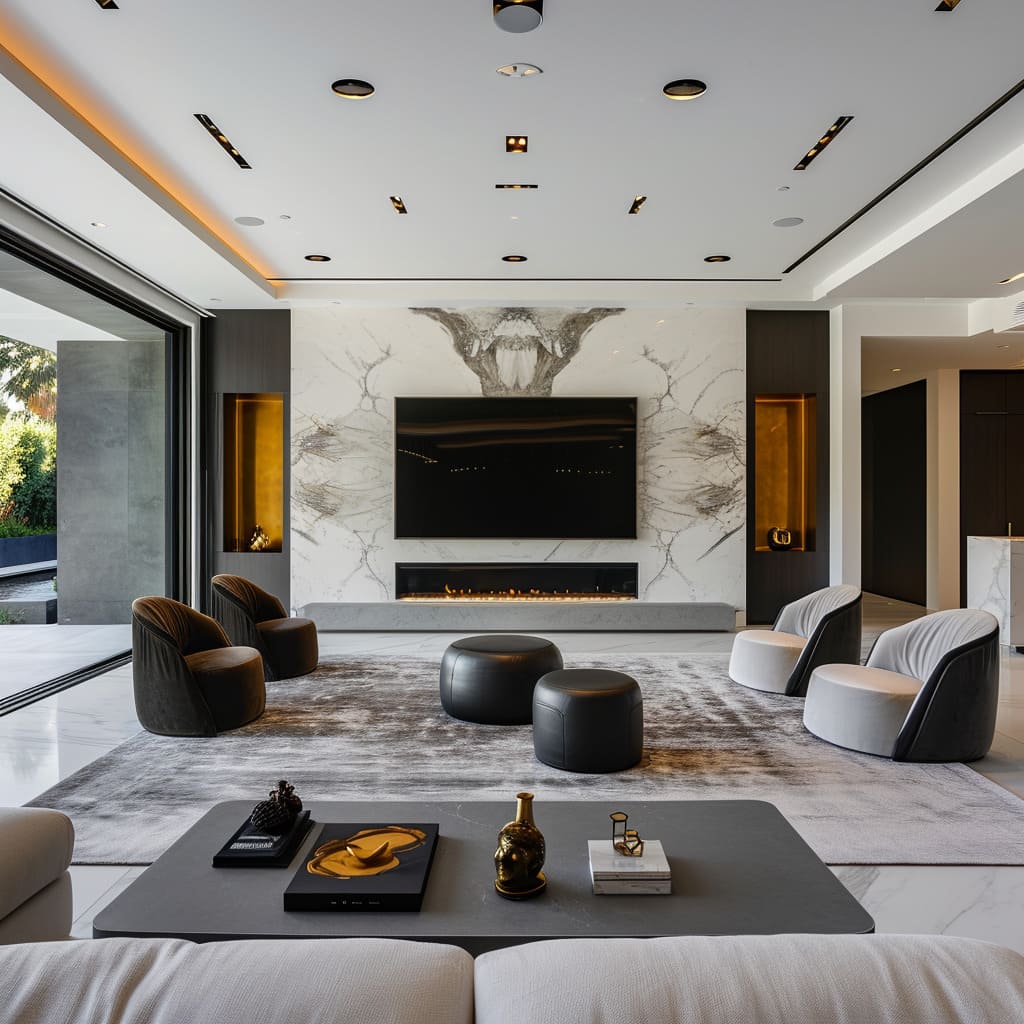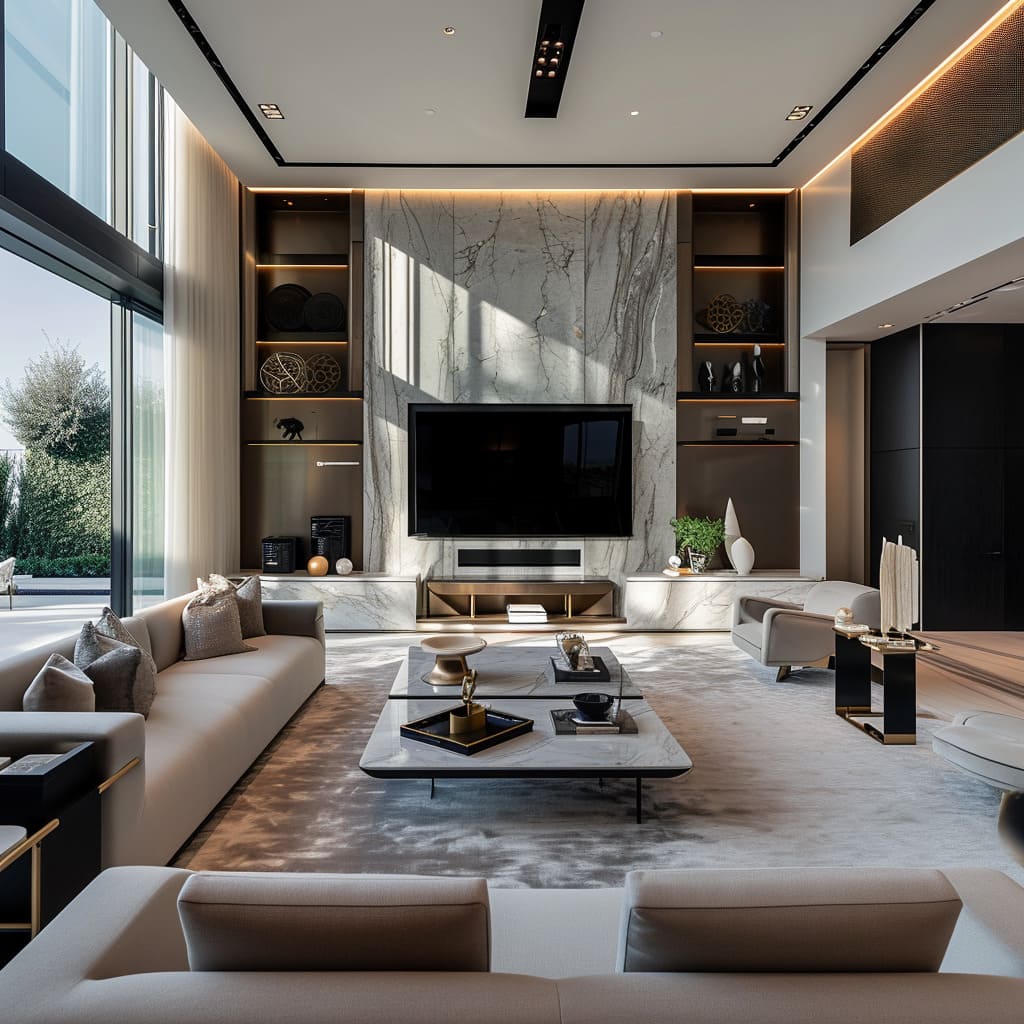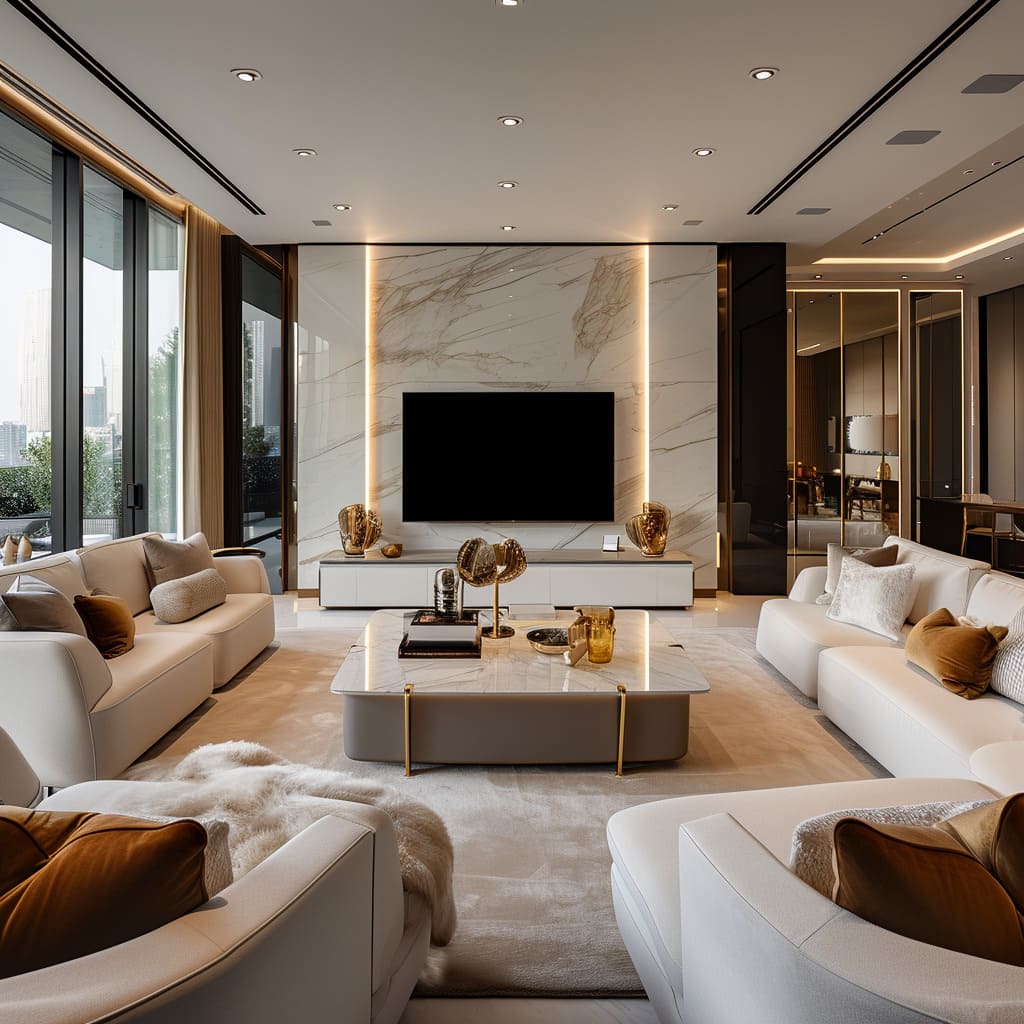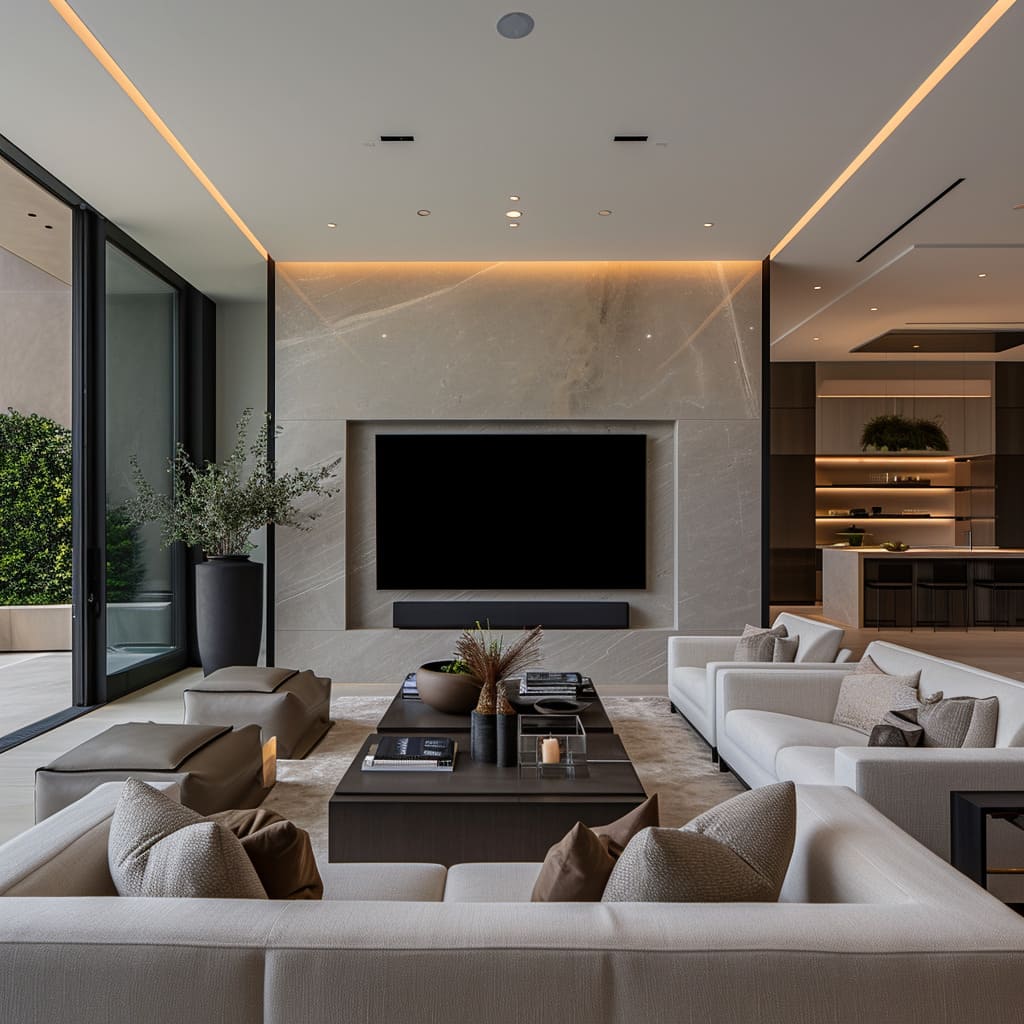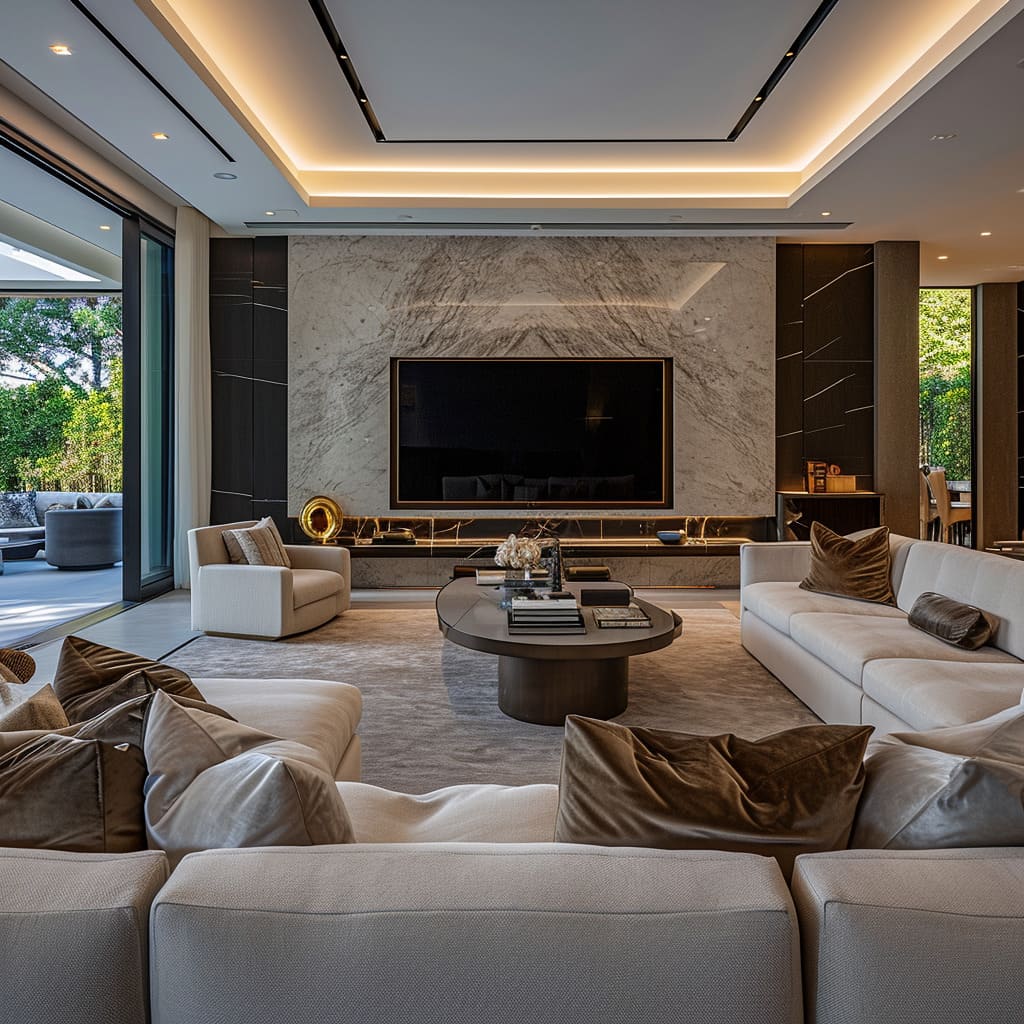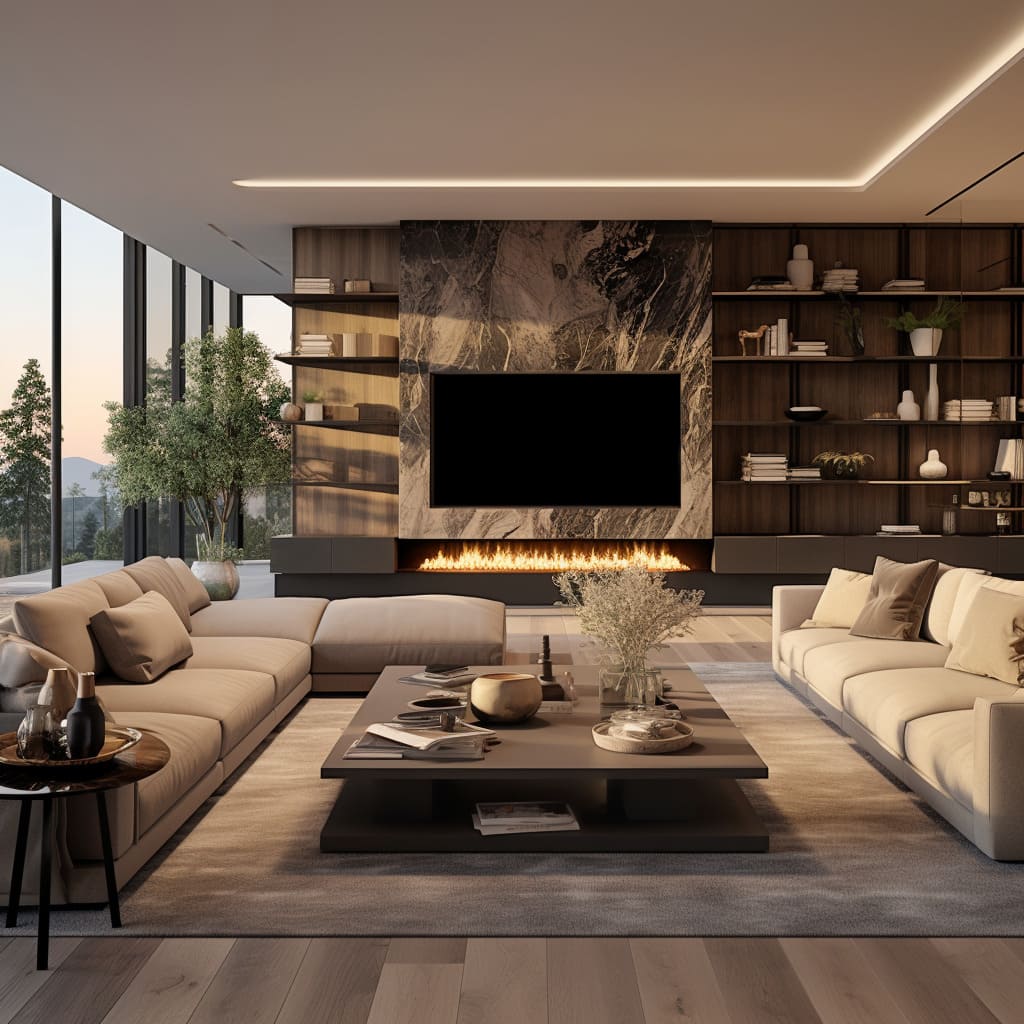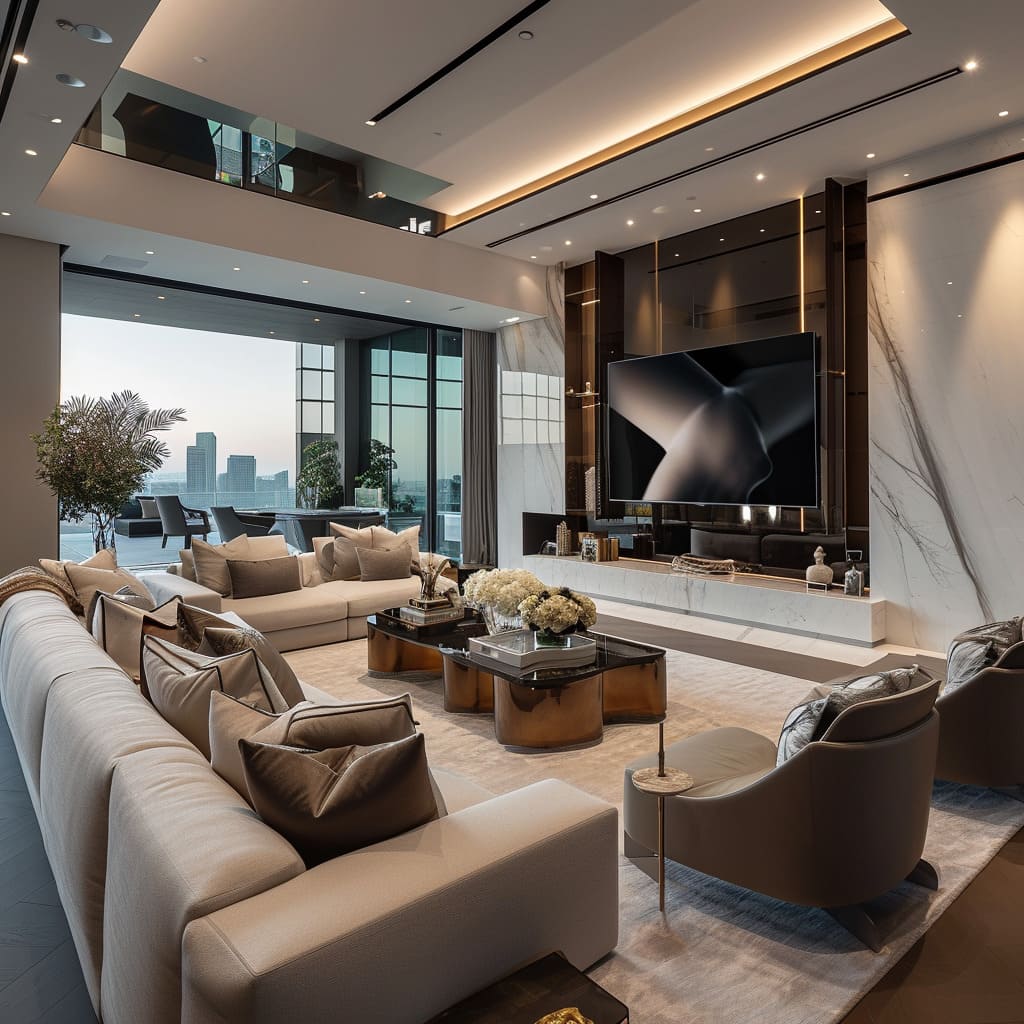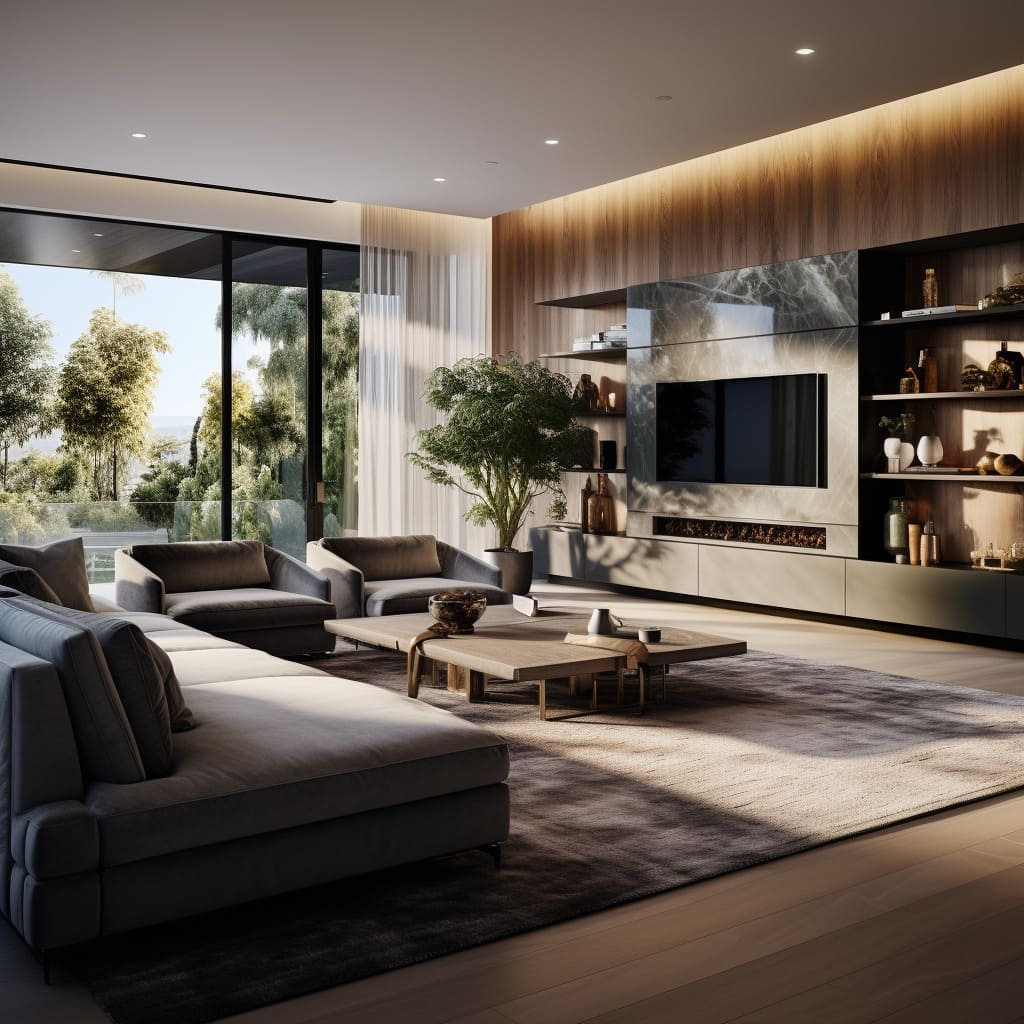In the modern era of interior design, where the television plays a central role in our living spaces, the art of creating inviting, functional, and aesthetically pleasing environments has evolved dramatically. Gone are the days when a TV was merely an accessory; in today’s homes, it is often the focal point around which entire rooms are designed and decorated.
This shift has given rise to a new paradigm in interior design, one that melds technological innovation with sophisticated style to create TV-centric living spaces that are both visually stunning and experientially enriching.
Here we delve into the intricacies of crafting spaces that are not only conducive to viewing and entertainment but also reflect the changing dynamics of modern living. In these interiors, the television is more than a screen; it’s a window to the world of entertainment, information, and connectivity.
The challenge and opportunity for designers lie in integrating this essential element into living spaces in a way that enhances, rather than detracts from, the overall aesthetic and functional harmony of the home.
This journey into the heart of TV-centric design reveals a meticulous approach to every aspect of the living space. From the strategic placement of plush, comfortable sofas and chairs optimized for viewing pleasure to the use of specialized wall panels and soft furnishings that enhance room acoustics, every detail is carefully considered.
The result is a harmonious blend of comfort, style, and functionality, creating spaces that are not just about watching TV but about experiencing it in a whole new way.
The rise of large, high-definition TV screens has transformed them into statement pieces, around which the rest of the room’s decor is thoughtfully arranged. This has led to innovative design solutions that balance the visual weight of the screen with other elements of the room, ensuring that the TV integrates seamlessly into the overall design scheme.
Furthermore, the introduction of smart home technology and advanced sound systems has added a new layer of complexity and opportunity to TV-centric design. Now, living spaces can be tailored not just to the visual and comfort needs of the inhabitants but also to their auditory and interactive preferences.
The integration of these technologies into the design process represents a forward-thinking approach to living space creation, one that embraces the future while respecting the fundamentals of good design.
As we delve deeper into this article, we will explore the various facets of TV-centric interior design. From the selection of furniture and accessories that complement the dominant presence of the TV, to the thoughtful arrangement of these elements to create cohesive, comfortable, and engaging environments, this exploration will highlight the creativity and innovation that define modern interior design.
Welcome to the world of television-centric living spaces, where design meets entertainment in a symphony of style and functionality.
The Art of Modern TV Unit Design in Contemporary Interiors
In interior decoration, the living room undergoes a transformative journey through the integration of modern TV unit designs, where luxury meets functionality. These designs stand as testaments to the harmonious blend of varied materials, colors, and textures, thus establishing themselves as central focal points in contemporary living spaces.
The essence of these designs lies in their seamless fusion of aesthetics and utility, transforming the traditional concept of TV stands into integral components of room decor.
The character of these units is marked by their sleek, contemporary styling, where clean lines and minimalist design philosophies reign supreme. A prominent feature in many of these designs is the use of natural elements, particularly marble, which brings an air of opulence and natural beauty.
The way marble is lit, often with subtle LED backlighting, not only illuminates its intricate patterns but also creates a warm, inviting ambiance in the room.
Concurrently, there exists a trend towards minimalism in some of these units, where the finishes – either matte or gloss – are chosen in neutral tones. This choice ensures that the TV units harmoniously blend with the overall color scheme of the living room, enhancing its aesthetic appeal.
These units often stretch across walls, not only providing a platform for the TV but also serving as a stylish base for displaying various decor items like books, vases, and sculptures. This design strategy emphasizes horizontal lines, lending an illusion of spaciousness and openness to the room.
From a functional perspective, these TV units are thoughtfully crafted to include a blend of open and closed storage solutions. The open shelves offer a stage for tasteful display, while the closed compartments neatly conceal electronics and other items, maintaining the sleek, uncluttered appearance of the room.
This balance between display and storage is a key element in maintaining the unit’s aesthetic integrity.
The seating arrangements in these living rooms are curated with a keen eye for comfort without compromising on style. Sofas and armchairs are often upholstered in luxurious fabrics like velvet or leather, inviting relaxation.
The color schemes of these furnishings are typically kept neutral, allowing the TV units with their standout features to capture attention. Accents such as pillows and throws are incorporated to introduce texture and color, enhancing the room’s overall appeal.
Lighting within these spaces plays a pivotal role in setting the mood and highlighting the design elements. The integration of spotlights or strip lighting within the TV units themselves serves a dual purpose of functionality and ambiance enhancement.
The use of marble, a distinct element in many of these units, adds a touch of timeless luxury. Its unique natural veins and color variations make each piece one-of-a-kind, contributing significantly to the room’s aesthetic.
In some designs, marble extends beyond the TV unit, flowing into adjacent wall features or fireplaces, creating a sense of continuity in design and material usage. This extension of marble not only elevates the sense of luxury but also enhances the spatial brightness as its polished surface reflects light beautifully.
The strategic placement of lighting accentuates the marble, bringing out the depth and intricacy of its natural patterns.
Marble’s choice in these designs speaks to its durability and longevity, standing as a material that endures over time. Its cool, tactile surface provides a sensory contrast to the warm textures of the room’s soft furnishings.
Often, marble is paired with other materials like dark woods or metallic accents, creating a visually appealing contrast. This juxtaposition brings together the cool, hard elegance of marble with the warm, inviting textures of wood or the sleek shine of metal, adding a layer of complexity to the design.
These TV unit designs embody a design ethos that values the interplay of nature and expert craftsmanship. The meticulous cutting and finishing of marble for these units showcase the stone’s natural beauty within the modern interior design context.
This incorporation of marble is a celebration of natural beauty in a contemporary setting, providing a luxurious focal point that anchors the living room with both visual impact and timeless appeal.
In conclusion, these living room designs represent the pinnacle of modern luxury. They exemplify a perfect harmony of form and function, materiality, and a commitment to creating a central, visually stunning yet highly functional hub.
These spaces are a testament to design that not only caters to daily living but also stands as an artistic statement, redefining the concept of luxury and comfort in modern living spaces.
Furnishing for Modern TV-Centric Living Spaces
In modern interiors where large TV walls dominate, furniture selection is a key factor in creating a space that balances aesthetic appeal, comfort, and functionality. Central to this design philosophy is the choice of sofas and chairs, designed to foster an inviting atmosphere conducive to relaxation and entertainment.
Sofas, often the heart of the living room, are selected for their generous size and plush comfort. Upholstered in high-quality materials like soft chenille, durable tweed, or luxurious leather, they provide both tactile pleasure and lasting durability.
The color palette for these pieces typically features neutral tones such as taupe, beige, and gray, offering versatility and a calming effect. These large sofas are designed with deep cushions and padded armrests, inviting users to sink in and unwind.
Modularity is a key aspect of these sofas, allowing for flexible arrangements to accommodate different numbers of viewers or to alter the room’s layout as desired. Features like chaise sections or extendable footrests are common, enabling users to stretch out comfortably for extended viewing sessions.
Complementing the sofas are accent chairs and loungers, which are not only comfortable but also aesthetically pleasing. These chairs often feature sculptural designs with ergonomic considerations, like high backs for privacy and support, and open designs to maintain spatial flow.
The arrangement of this furniture is intentionally oriented towards the TV wall, ensuring optimal viewing from every seat. The layout is designed to encourage social interaction while also providing an unimpeded view of the screen.
Furniture positioning takes into account the optimal distance from the screen to enhance viewing comfort and reduce eye strain.
Coffee tables and side tables within these spaces are selected for both their functionality and design appeal. They provide convenient surfaces for everyday items and often include additional storage features.
The materials and finishes of these tables are chosen to complement both the upholstery and the TV wall unit, ensuring a cohesive interior aesthetic.
To enhance the comfort and visual appeal of the furniture, accessories like pillows and throws are often used. These not only add color and texture but also provide additional support and warmth, enhancing the overall comfort of the seating.
The concept of a ‘viewing zone’ is central to the furniture arrangement, creating a dedicated area optimized for TV enjoyment. This arrangement encourages a communal viewing experience, perfect for family gatherings or social events.
Lighting is also a crucial element, with strategically placed lamps providing ambient light that enhances the viewing experience without interfering with the screen. Dimmable options and smart home technology are often incorporated for added convenience and adaptability.
The textures and materials of the furniture are carefully chosen to create a harmonious sensory experience. The balance of plush fabrics with sleeker materials like leather adds depth and interest to the space.
Furniture proportions are carefully considered in relation to the TV wall and room size, ensuring a balanced and harmonious environment.
Occasional seating options like ottomans and poufs offer versatility, serving as additional seating, footrests, or tables as needed. These pieces enhance the room’s functionality while maintaining a sense of openness and flexibility.
In summary, the furniture selection in these TV-centric interiors is meticulously crafted to create a luxurious, comfortable environment focused on relaxation and entertainment. The thoughtful combination of style, comfort, and quality ensures these living spaces are not only visually appealing but also serve as a haven for relaxation and social interaction.
Style and Sound: Acoustic Design
In the world of interior design, an increasing emphasis is placed on the auditory experience, particularly in spaces designed for entertainment. Designers, with a keen understanding of acoustics, meticulously integrate materials and design features that enhance the room’s sound quality, ensuring an immersive audio experience that matches the visual splendor.
Specialized wall panels play a crucial role in this acoustic optimization. These panels, often adorned with geometric or textured patterns, not only add to the room’s aesthetic appeal but are also pivotal in managing sound reflections and absorptions.
Placed strategically, they work effectively to dampen echoes and reverberation, resulting in a crisp and clear sound quality that perfectly complements the high-definition visuals on the TV screens.
The careful selection of rugs and carpets is another important aspect of acoustic design. Beyond their visual appeal, these floor coverings play a significant role in absorbing sound, counteracting the effects of hard surfaces that can cause undesirable sound reflection.
Designers opt for thick, plush fabrics in these carpets and rugs, not just for their aesthetic appeal, but for their sound-absorbing qualities, contributing to a serene and noise-free environment conducive to an immersive cinematic experience.
Soft furnishings are selected with a dual purpose: aesthetic appeal and sound absorption. Luxurious throws, overstuffed pillows, and upholstered ottomans are not just decorative elements; they are integral to the acoustic design, contributing significantly to the reduction of ambient noise and enhancing the overall auditory experience.
Furniture choice is also influenced by acoustic considerations. Couches and chairs, often filled with high-density foam, serve a dual purpose: providing comfort for the occupants and aiding in sound absorption.
This furniture design ensures that sound does not escape the intended area, allowing every line of dialogue and musical note to be heard with clarity and depth. Additionally, the layout of the furniture is planned to facilitate optimal sound distribution, with sufficient spacing between pieces to allow sound waves to flow unimpeded, creating an enveloping sound field that draws viewers into the narrative unfolding on the screen.
Style and Sound: Acoustic Design
In conclusion, acoustic considerations in modern interior design are not mere afterthoughts but are integral to the planning and execution process. Designers skillfully use specialized materials and strategic layouts to create spaces that are not only visually stunning but also acoustically refined.
These interiors become sanctuaries for audiophiles and movie enthusiasts, where the quality of sound receives as much attention and reverence as the quality of style.
In the field of modern interior design, the harmonious integration of style and sound emerges as a pivotal theme. This article has highlighted the meticulous efforts of designers in crafting spaces that are not only visually stunning but also acoustically superior.
The convergence of aesthetic appeal with auditory excellence defines these interiors, where every element, from specialized wall panels to plush soft furnishings, is chosen with a dual purpose: to enhance the visual allure and to refine the auditory experience.
The attention to detail in the selection of materials and layout showcases a deep understanding of how sound interacts with space. The strategic placement of sound-absorbing wall panels, the thoughtful use of plush carpets and rugs, and the careful choice of soft furnishings all contribute to creating an environment where sound is not just heard, but experienced.
The furniture, too, plays a vital role, serving as both a comfortable haven and an acoustic ally, ensuring that every note and dialogue is delivered with clarity and depth.
Ultimately, these interior spaces stand as testaments to the skillful blending of form and function. They cater not just to the eyes but also to the ears, offering a complete sensory experience.
This fusion of aesthetic and acoustic design creates environments that are more than just visually appealing or comfortable—they are immersive, enveloping the occupants in a cocoon of style and sound. In these thoughtfully designed spaces, every moment spent is a symphony of sensory delights, making them ideal sanctuaries for relaxation, entertainment, and ultimate enjoyment.


